#rather than literally adapting existing legends
Text
its kind of absurd how far ive made it without becoming a touhou fan
ive always been super inspired by japanese folklore, ive always been super inspired by colorful ornate multilayered costume design with frills to the max, ive always been super inspired by danmaku (the patterns and animations not the gameplay lol), touhou soundtracks have been my goto for inspiration music my entire art life, like 90% of the stories ive written are surreal whimsical mishmashes of wide ranges of paradoxical concepts with heavier undertones, i cut my worldbuilding teeth on reinterpreting scattered shinto mythos as structured spiritual heirarchy the same way tolkien did with european paganism in his early days
but out of everything thats failed to catch me for years, the thing thats finally gonna get me is the game about running an izakaya
i literally cannot resist izakaya and yatai their spirit has occupied a spot in my soul since who knows when i was first exposed to then
#mystias izakaya is also the first touhou game ive encountered that writes the characters as yokai that are just depicted as anime girls#instead of just anime girls with a few yokai traits#its like Ohhhhh i get it now. touhou is supposed to be Spirited Away but with the Moemon sprite mod#in a well written one the moe part is just on the surface and theyre actually just straight up yokai. Bad Ass#but now ive got the conundrum of do i get into touhou or keep distance cause i wanna still write yokai stuff without being influenced by it#then again i think touhou is more wide than it is deep so maybe itd be fine#i already love okami and oreshika#though i resonate far more with Totoro and Spirited Away. shinto lens and dynamics but original mythos with a unique dynamic of its own#rather than literally adapting existing legends#man watching totoro when older and realizing its hidden layer about building an original mythos for a region's forest and wind was amazing#it was like YES i loved totoro when younger and now i find all along it was about the same kinda stuff i write this is where im meant to be
10 notes
·
View notes
Text
I watched a movie made in this century and everyone is very impressed
On Friday I watched 2021's THE GREEN KNIGHT. I really liked it! I had a good time! I am not a person who knows or understands movies, particularly contemporary movies (whereas when I'm having attacks of confidence, I can usually acknowledge I have Some book knowledge)!
I did, however, do a seminar in medieval literature and so I've studied the actual text of "Sir Gawain and the Green Knight" and similar poems.
The thing I really liked about THE GREEN KNIGHT is that it FEELS like an adaptation of the 14th century poem, instead of an adaptation of a modern text based on a telephone game version of an Arthurian legend hodgepodge. It's dirty and unglamorous and sexual, instead of pristine chivalric. None of these things mean it's drab, though. I'm used to people approaching the Arthurian legend with a heavy chivalric fantasy lens, with genre fiction writers especially leaning into the fantasy element, or armed with the HISTORICAL FIGURE OF KING ARTHUR mindset which for some reason translates as drab still historically inaccurate stabbing with horses.
(There is a third popular approach, which is weirdass time travel reincarnation but I think that's mostly in books and comics.)
When I say THE GREEN KNIGHT is dirty, I mean it in a textured way, rough and crumbling stone, scrubby moss, sticky blood, lived in and rotting in a natural way. Because the thing about THE GREEN KNIGHT is that it hits the strange space medieval literature was created in by acknowledging and embracing the clash between the pre-literate paganism and the literacy brought with Christianity (moreso than the centuries after the fact recordings of stories from Norway and Iceland). David Lowery clearly favours the natural pre-Christian state and a return to same, which may be the most modern aspect of the adaptation, with the King and Queen heavily adorned with holy imagery while being sickly and faded even when compared to the Mother, and the first thing Gawain encounters leaving the city being the rotting remains of a massive battlefield being pecked over by scavengers. Things become more vibrant and alive the further Gawain gets from this core of Christian civilization, even though it becomes increasingly dangerous.
In a lot of medieval literature, we encountered a tendency where the non-Christian elements were TOTALLY RAD while we also had to acknowledge the order and rules and hierarchy of Christianity was Good, even if it wasn't nearly as TOTALLY RAD as a half-demon baby biting off the nipples of many, many wet nurses.
Even though Lowery's take on the inevitable return to nature is contrary to the righteous Christian goals of the original text (although not so much in "Sir Gawain and the Green Knight" as it is in other works), the result is much the same in the nature of Gawain's quest. The strangeness and danger and beauty of the natural world, the conflict of chivalric codes and the rules of folklore, the fact that the plot stems from Gawain's flaws as a person. Strange things happen and they're accepted with minimal question. A part of the world that is frightening but still known to exist.
Portrayed by Dev Patel, Gawain's flaws are less character flaws than they are the correctable flaws of youth. He's impulsive, quick to act and slow to think, and naïve in both halves of the world. It lets the character journey become one of maturation through the quest, rather than being an archetype going through the steps of a quest.
It was just a good time. Beautiful and sometimes hypnotic and ambiguous in a way I appreciate both because of the inherently ambiguous, 'lost' nature of these source texts, and also because it makes the real goal of the quest an inner question of self without tying it to outside validation for Gawain.
2 notes
·
View notes
Note
What’s this about a New Ionian champion?
okay so i got this info by a spanish youtuber so maybe this is going to end up on a telephone game. But i'll pass the info as literally as i can:
this video recopiles shortly all we know about a new champion riot defined as 'ink mage' specifically focused on midlane.
this champion was originally going to be released 5-6 years ago, but they didnt have enough resources to make the abilities work, etc, so it was originally cancelled and rescued this year.
Riot has already discussed about this champion 2 years ago, when a fan said that they should chat more about the concept of the ink mage. To wich Riot Meddler responded that they would, but that they didnt release him because a lot of the ideas were more practical on paper, but quite difficult to recreate ingame (wich leads to the lack of resources, and why he was initially cancelled 5-6 years ago).
Riot's idea was that you could draw the abilities. The video even in spanish includes a little video (i assume is official? but i dont see the typical riot pbe checkmark, so it could probably be fanmade, i dont know personally). Like for example, draw a straight line for a basic damage ability, a square for a stun/root, or a circle for a knockup like Taliyah's one.
They are unsure if they should discard this idea since it could be difficult to apply ingame or if it would be frustrating to play aganist. It could be a very tricky and difficult champion to play as in a teamfight.
Riot has already talked about this champion oficially, but i cannot find the source in english, just the screenshot in spanish used in this video. To be completely honest, its a very confusing text. As if the champion was real and he was the one doing his own splashart...? Its a very weird text. There's nothing really of interest rather than saying that this supposed artist champion is a complex, complicated and somber, with surely a tragic past (gee, how original...) They just explain by this that they dont have an illustration yet, hence why he hasnt been leaked yet with his splashart. I assume that they are still on the making or just havent released it to the pbe.
Riot has suggested that the champion might be released by the end of the year. So, its pretty much still on air.
i've found this reel on youtube that also explains some of the things i translated from the spanish video. I havent really heard about this account before but, if you wish to know:
i know this champion is literally just concept not even an illustration has come out but... yeah, another Ionia champ. Artist, as if Jhin didnt exist on 2016, bruh. Couldnt they just try to adapt the champion to another context or region...? It just feels fucking wacky imo
#i have seen a lot of videos of this spanish youtuber#he has been almost always on the right so#im trustful#anyone remembers that 'warrior handicapped ionian archer'?#that concept that was also flying around this year?#i just dont know if they discarded her completely#anyway: ionia wins again#'wohooo...'
1 note
·
View note
Note
Out of the receng worldbuilding asks: 2 (because any excuse to hear more about perytons is good); and mayyybe 5 (because if you have thought about it before then you really have a fully functional world).
2 What sort of magical creatures exist in your world? (Dragons, fair folk, spirits, etc)
Magic is a very broad term, but I know what you mean. Unusual creatures in the setting include but are not limited to:
Perytons! Deer with wings and teeth. Generally flightless. Tend to linger around herds of true deer and prey on the predators. Typically a symbol of the strong protecting the weak, and as such symbolic of The Hunt. A symbiotic relationship.
Ornixes! Large breeds are also called dragons, but in reality this is just the collective term for therapod dinosaur-like creatures. Small breeds tend to be very intelligent and clever, comparable to modern birds. Larger species are much more animal, and built to kill. Viewed similarly to sharks as graceful and beautiful but incredibly dangerous, even if they generally avoid human populations.
Aurochs! A collective term for megafauna in general, including what we'd recognize as elephants, Sauropod dinosaurs, Pleistocene mammals, etc. Auroch is most often a generalized or collective term, like cattle, for when these creatures are used as beasts of burden or otherwise raised under human care.
Giant spiders! They're literally just called spiders. Spidersilk is a valuable material within the setting. Coarse spider hair is useful to make brushes or cleaning materials, and shed exoskeletons can be used to reinforce gear or make armor. The venom of most large spiders is actually only harmful to humans in large doses, but a bite will still be lethal (duh). There are also other abnormally large bugs, but spiders have worldbuilding significance.
Don't get me started on what might be in the ocean. Since there's one primary landmass and most people use the inland sea.... yeah.
Magical creatures - magically influenced people, for the most part - tend to influence the idea that creatures like the above are reflections of other creatures, rather than a world where these creatures never existed at all. It's much more symbolic. Speaking of which, magical people-creatures (Fair Folk) can be condensed into 2-4 categories:
Unseelie. Most comparable to the animal reflections of people. Sharp teeth and nails, blood cravings as a side effect, heightened senses honed for nighttime predation. Many consider them closer to ornixes or perytons than people, even if that's wrong, because it's better to believe you couldn't become like that.
Seelie are easier to live with. They're unusual, sure - their hair is strange colors, their eyes are bright and eager, they live life on the edge and recklessly, their bodies are nearly indestructible. They'll do anything in their power to cheat you if it benefits them. But they can't lie. They won't eat you. Oftentimes their demands are somewhat reasonable. And they always stand by their word. Sure it's by compulsion, but hey, at least they're not going to eat you, and even if there is an unfavorable bargain, it's very likely you'll outlive them.
Wulvers are a subclass of Seelie, or once were, according to legend. Every region has its wulvers, adapted to its climate: Arahas has bouda, hyena-men; the Protectorates and North see kitsune, foxfolk; the Forest region has more traditional werewolves; Brydlen has folk that can take the shape of great hounds, called Faoladh; the Basin, coyotes; and in Zanoma are Lobisomem, who appear as maned wolves. They share most of the primary Seelie traits, that is, liability to fast living, near invulnerability-- although, rather than iron as their Seelie cousins, they're vulnerable to silver weapons. There are two primary differences: 1. They have an average human lifespan, believed in different Wulver cultures to have been earned by one of their ancestors tricking death; and 2. they have a co-dependence, and often serve as protectors of their human communities. A wild, vicious Wulver is a force to be reckoned with, however, almost as fierce as an Unseelie and equally dangerous.
Finally, there are normal humans who can channel magic in little ways. A voice that can bend people to their will; sparks of fire; bursts of electrical discharge; an abnormally green thumb; temporary invisibility; speaking the language of animals. The causes of this are yet unknown, but no one with these abilities is more or less likely to become Seelie or Unseelie, and it doesn't seem to be genetic. Sometimes your child just starts talking to a cat and you have to be open to accept that.
Thank you for the ask! The worldbuilding questions can be found here, for anyone else interested!
6 notes
·
View notes
Text
Dev Patel and the Green Knight
I finally got around to seeing The Green Knight. Overall, I enjoyed it--David Lowery does a good job capturing the essential weirdness of the tale, which is very much about taking a mundane circumstance (a Christmas feast) and suddenly catapulting the reader into a mythic otherworld through the intrusion of the alien and monstrous, and the fantastical costumes, dramatic lighting, and dissonant score all contribute very well to a sense of otherness that permeates the original story.
But I find it interesting--and, I'll admit, a little frustrating--that no modern film adaptation of medieval literature is really capable of taking the story it's adapting on its own merits. This isn't an objection to modifying the source text, or taking it in new, non-literal direction. I can think of plenty of adaptations of work that play with the source material in interesting ways, and are better for it. Even very faithful adaptations like Peter Jackson's Lord of the Rings are inevitably going to alter the source based on the need to adapt it for the screen and the whims of the director. But when it comes to medieval classics, texts like Beowulf or Gawain and the Green Knight are always held at arm's length. An ironic layer is always interpolated into the original story, and even in modified form the story is never allowed to stand on its own.
Contrast, for instance, modern retellings of Arthurian legend; or Wagner's Nibelungenleid; or something like Neil Gaiman's book of Norse mythology. These are all adaptations of much older stories, all medieval; and the authors typically happy to let the stories operate on their own terms. In fact, that is often a selling point: dipping into these tales is a way of sampling an alien culture, one that is remote from us in time rather than space, and part of the sense of heightened drama is the understanding that these stories do not necessarily depict the world in the same way that modern realist prose does. They are fairy-stories, in the Tolkienian sense, and something not quite even like "high fantasy," which, although it is a genre which owes much to the mythic tradition, is usually *told* in the same manner as other realist fiction. And you could take these stories and re-cast them in a realist mold--that's definitely been done with Arthurian legend, either via anachronism or trying to place them in an era-appropriate historical context, and even that yields something quite like the original in tenor, even if the language used to relate the story is often very different.
Watching this movie, I was *strongly* reminded of Robert Zemeckis's Beowulf, in that this did not feel like an attempt to adapt Gawain and the Green Knight for the screen. It felt like an attempt to tell a story *about* Gawain and the Green Knight (the text), a story which does not stand on its own. You don't have to have read the text to understand the movie (although I think some directorial decisions would be a bit mystifying if you hadn't), but the movie definitely situates itself *as a response* to the text. Which is an odd choice! Actually, another good point of comparison is Spike Jonze's Adaptation. It started life as an adaptation of Susan Orlean's The Orchid Thief, but Charlie Kaufman sort of gave up writing that halfway through and wrote a movie about the difficulty he was having writing *that* movie, and the result is something very weird (and very good) that is full of metafictional elements that depend on the existence of this other work, in a way that a straight retelling of The Orchid Thief for the screen obviously would not. And while The Green Knight isn't that extreme, it is definitely playing on the structure of the medieval poem, and replying to it.
The core of the movie (as I understood it) is a tension between young Gawain's aspiration to knightliness, his ambition which is born at least in part from his mother's encouragement, and his own failure to live up to the heroic ideal of greatness. Not chivalric--this is a movie in which the ethos of chivalry makes not even the briefest of appearance, which is weird given that it's nominally an Arthurian romance, and that the chivalric ethos is extremely important to the original text. Instead we have a generic greatness being described, one which is associated with renown, with taking part in mythic events, and with achieving high rank and honor. In the service of seeing her son obtain all this, Gawain's mother seems to cast some kind of spell, whereupon the titular Green Knight appears at Arthur's Christmas-feast; and as in the poem, a game of beheadings is proffered. Gawain accepts the challenge, beheads the knight, and the knight rides away, promising he'll meet Gawain a year and a day hence at the Green Chapel. So far so straightforward. When Gawain sets off a year later to meet the knight, his mother gives him an enchanted belt to keep him safe from harm. Gawain goes on to have a couple of side-of-the-road adventures and mishaps, the kind of thing that's par for the course when you're telling an Arthurian romance, until he arrives at the house of a mysterious benefactor, just about a day away from the Chapel, who grants him hospitality until the day of his challenge.
Now, in the original story, this is where Gawain gets the magic belt, and it's hugely important: Gawain and his host promise to exchange anything they might receive at the end of each day, when the host has been out hunting all day and Gawain has been in the house recuperating from his travels. During this time, the host's wife repeatedly tries to seduce Gawain; and Gawain is trapped between the imperative not to sleep with his host's wife (a major violation of the rules of good chivalric conduct!) and the imperative not to offend the woman (also a violation of those rules). He succeeds, for the most part; he is forced at one point to give his host a kiss at the end of the day, since the wife kissed him; this is shown as him holding nothing back and acting in good faith on the vow he made to his host. When Gawain finally rebuffs the wife for good, she insists that, even if he won't sleep with her, he should at least take a magic belt she has woven that will keep him from harm. He does; but he does *not* give this to his host. When he finally goes to the Green Chapel, the Knight returns the original blow as promised--but only nicks Gawain lightly. He reveals himself to be none other than the host who was sheltering him; the nick was his reprimand for withholding that final gift, but because of his good conduct he is otherwise left unharmed. The whole thing was a test of sorts, one which Gawain passed. Despite flinching at first from the blow, and keeping the belt secret, he shows himself ultimately to be a man of good (albeit not perfect) conduct, and *that* is why he wins honor from the whole affair.
The movie takes this basic narrative and alters it in key places, completely changing the valence of the whole thing. First, Gawain gets the belt at the beginning of his quest, as mentioned; he loses it on the way, but when he reaches the castle, the wife of his host (who succeeds in seducing him with a handjob) presents it to him as if she had woven it herself. He does not actually engage in the game of exchanged with his host, who is *also* not the Green Knight. And we're treated to a monologue about the color green from the wife that feels beat for beat like it's been ripped off from someone's undergraduate essay about Gawain and the Green Knight, which is a little weird even in the context of the rest of the movie. Finally when Gawain reaches the chapel, the knight goes to return the blow--and Gawain completely chickens out and flees. We are then treated to an extended sequence of Gawain returning home; being feted as a hero; earning his knighthood (presumably by lying about what happened); succeeding Arthur as king; him abandoning his low-class beau once she bears him a son, and marrying a princess; going to war; his son dying in a war; and finally, as an old man, being trapped in his throne room as a besieging army breaks its way inside. Just before they do, he removes the magic belt from around his waist, his head fall off, and bam--we're shown this has been an Occurrence At Owl Creek Bridge thing this whole time, and the Green Knight has not yet landed his blow.
Gawain finally takes off the belt, throws it aside, and tells the knight to go ahead--and the knight bends down and congratulates him. In context, the reading seems to be this: the belt is a talisman of Gawain's mother's influence, of external expectations for what kind of man he is. The Knight is Arthur or perhaps an agent of his, and the test in *this* case is whether Gawain can be his own person. All the events leading up to this point are perhaps a part of the original magic Gawain's mother cast, an effort to Lilith Weatherwax her kid to greatness by putting him into an epic story. Implicitly, then, the Gawain and the Green Knight we all know is the false version of the tale, the tale as Gawain's mother would have it told.
This is all very clever. But I'm afraid it's so clever it falls apart in the end. Because the structure of the original story that this depends on is dependent in turn on taking the whole notion of chivalric virtue seriously, which this movie plainly does not. Gawain is shown as irreverent and lustful and a bit of a party animal--lovable and good hearted fundamentally, but definitely not an Arthurian hero. That's fine, but that's a very modern sort of character, one that feels out of place in a movie that is trying very hard also to be tonally unmodern, firmly embedded in a mythic otherwhen of Arthurian legend. Moments of slice-of-life mundaneness, while charming, strain mightily against the epic tone the movie tries to take in other places, and strange events like a ghost seeking her lost head or immense giants striding the landscape. We are jostled: are we in the land of myth? Or are we in historical Britain? We cannot be in both!
And this is a movie that was definitely made by people who had read the original text; not just the original text, but also a great deal of criticism *about* the original text. The movie namechecks the theme of fivefold symmetry that's incredibly important to the structure of the poem; there's the aforementioned undergrad essay about colors about 3/4th of the way through; and there's the fact that the structure of the original plot (down to Morgan LeFay in disguise as an old woman in the host's castle) is present in altered form in every detail. But none of these details add up to much. There's a weird homoerotic kiss with the host that implies that in fact *he* wanted to sleep with Gawain, in addition to his wife; the ghost Gawain encounters early on tells him the Green Knight is in fact someone he knows (and therefore *can't* be the host; I think it's implied to be Arthur, like I said, but this is never quite confirmed), and while all these things *about* the original poem are shown, none of them ever get integrated thematically into the plot.
I think as a result, whatever Lowery was going for, the whole movie kind of falls apart in the end. And that's a pity, because somewhere in there is just a really weird, visually striking, really gripping, embellished-and-polished-for-modern-sensibilities-but-also-thematically-true-to-the-source retelling of Gawain and the Green Knight. And that would have been a much better movie! What are we to make of this, a movie that purports to be telling a story-behind-the-story, but one that leaves no room or context for the original? After all, Gawain in the end does *not* flee, does not return home a coward and a liar; presumably, he earns his honor, and can be honest about what happened. But if he is honest, none of the rest of what we have been shown makes a lick of sense, or has any point.
One feels a bit as if modern directors, when confronted with medieval texts being a bit weird, a bit alien in their worldview, instead of realizing that's actually something people like some of from time to time, feel like they have to construct an artificial bridge between the Middle Ages and the present day. But because it is invariably metafictional and self-referential, as if to say "don't worry, we know nobody REALLY wants to watch a bunch of boring medieval shit played straight," it comes off as cringing and ashamed of its source material. This isn't a plea for historicity! Gawain and the Green Knight is not history. But one does occasionally want to see an adaptation of one's favorite works without directors being ashamed of the text they are adapting! And since most people will not have read the original, I am rather confused about what the director intends for the audience to get out of all these references that are dependent on it, but don't stand on their own merits within the narrative of the movie itself.
The acting was good, the set design and costumes were terrific, I loved the slow and measured pacing and the weird score, and the design of the Knight himself, and the landscapes and almost everything else about the movie. So I don't think it's a waste of time, especially if you have read and enjoyed Gawain and the Green Knight, in the original or in translation. But it's definitely a pity to see a movie that was, well, *almost* great, but ended up merely OK.
#gotta put that undergraduate degree to work from time to time#we spent a *lot* of time on this poem
94 notes
·
View notes
Text
Myth, Legend, Folktale: How to Tell the Difference
There’s been some discussion of this recently, and I wanted to clarify the way academic folklorists understand these definitions. The short answer is that the category a given story falls into is based on CONTEXT, NOT CONTENT.
Basically, a myth is a sacred story told as truth (literal or metaphorical, but always cosmic), a legend is folk history (with a variety of belief options), and a folktale is told as pure fiction. Context is the best determinor of category, because a) it is predicated on how the people to whom the stories "belong" understood/understand them, and b) myths, legends and folktales often pass story elements around between them -- a story where a hero slays a dragon/giant serpent can be myth (Thor and the Midgard Serpent), legend (St. George, Beowulf), or folktale (Grimms' "The Two Brothers") -- so simply containing a particular story element, like dragon-slaying or gods*, is not enough to delineate a category. And even with those guidelines in mind, it's important to remember that these are not absolutely discrete categories, but overlap and shade into each other; a narrative can be told in a different category in various times and places, and even by different tellers.
Myths are *sacred* stories -- sometimes the very telling itself will be sacred -- that enshrine the Big Cosmic Truths of a culture: where the world came from, the relationship of humans to the divine, the foundation of sacred institutions like kingship or sacrifice, what happens after we die, and so forth. Myths are making a COSMIC truth-claim, which, depending on the culture and individual believer, can range from "metaphorical/poetic truth" to "literal/historical truth"; however, a myth's PRIMARY function is to convey a cosmic truth, so any historical truth-claim will be secondary. Religion is the SOCIAL apparatus that springs up around myths -- ritual, worship, liturgy, theology, festivals, hierarchy, and so on and so forth. Myths are the *stories* of a religion, and religion exists as a way of translating those stories into meaningful belief and action for human beings.
Legends are basically folk *history*; they take place in real time and real space as we know it, and are making an *earthly*, rather than cosmic, truth-claim. American Folklore: An Encyclopedia defines legend as “localized and historicized traditional narrative told as believable in a conversational mode” (437). Migratory legends (i.e., legends that spring up in a lot of different cultural contexts, like "The Sleeping Hero Under the Mountain") are often “oikotypified”--that is, the same story will be adapted in the telling for specific geographical areas: “The Dog in the Microwave” may be told by a New Yorker as taking place in Brooklyn, or by a Floridian as taking place in Palatka. Legends also tend to be about real or “real” people: King Arthur, Charlemagne, John Henry, “a man in Chicago who had just returned from Mexico.” Gods may appear, but in supporting roles, usually. Religious legends are auxiliary narratives to myths--they aren’t the central narratives of the religion, but they reflect and add to those narratives: saints’ lives are prime examples, and, indeed, that’s where the term “legend” comes from: L. legenda, “saint’s life.” A major thing about legends is that when the supernatural happens, it is a BIG DEAL: legends are about everyday or historical lived reality, and the busting through of the supernatural into mundane existence is presented as an anomaly worth noting. (Compare this to a fairy tale, where nobody bats an eye if, say, a frog talks.)
Legends have a HUGE variety of “belief options” available and are most liable to vary from individual teller to teller. They can be told as straight-faced truthful history by a believer to a believer, they can be told in a joshing half-believing way, they can be told as if they were ridiculous superstitions, they can be told as warnings against particular forms of behavior... It's worth noting that the “They say...” clause is more common in legends than in myths or folktales, because legends often occupy a greyer area of actual *belief* than those other categories do.
Folktales are folk narratives understood as fiction, and told for entertainment. Folktales may reflect and/or share story elements with myths or legends (and their respective truth-claims), but aren’t making any truth-claims on their own behalf other than that of art. There are several kinds of folktales: animal stories, “realistic” folktales (clever peasants and the like), and fairy tales, among others, most of which are self-explanatory. However, “fairy tale” is HUGELY problematic term in English, and requires some unpacking. Many scholars prefer the German term Zaubermaerchen, or its English equivalents “magic tale” or “wonder tale” for folk narratives, and reserve “fairy tale” for original, literary tales, like those of Andersen, Wilde, or Byatt; the term “fairy tale” itself comes from the English translation of the 18th-century Cabinet des Fees, a collection of literary wonder tales by French salon writers. (Another term used for these stories is the German Kunstmaerchen, “art tale.” Many folklorists prefer German folklore terms to English ones, because German terms tend to be more precise.) A major characteristic of these stories (both folk and literary) is that magic and the supernatural are treated as a matter of course: animals talk, people get turned into stone and back, magical objects abound, and no one ever behaves as if any of this is unusual or surprising. If it were, we’d be in legend territory--magical occurrences are, in everyday reality, something to be remarked upon, but wonder tales are expressly NOT connected to everyday reality. (That's Max Luthi's distinction, btw.)
A note on fairies: Most folk narratives about fairies are not fairy tales, but legends. Stories about fairies *as fairies* tend to be told as if they were true. They are often localized: there are fairies in those woods, Cadbury Hill is a fairy mound, Tam Lin appears at Carterhaugh.They’re historicized, too: while the teller may be vague on exactly when a specific incident happened, it is almost always told as if it were a part of lived history in the real world. Compare this to “once upon a time.” But what about all those fairy godmothers in fairy tales? Well, it is almost never important that they are *fairies*, as opposed to witches or talking animals. Vladimir Propp argued that it isn’t especially important, in a fairy tale, what a character *is*, but rather, what *role* he or she plays. Is the character a helper or a villain? It rarely seems to matter whether a villain is a witch or a stepmother or the Devil himself, because they all tend to behave the same way. Likewise, it doesn’t seem to matter much whether that helpful being the hero meets in the road is a beggar or a dwarf or a talking bear; their purpose is to give the hero good advice or a magical thingy, and their inherent beggar-ness or dwarf-ness or talking bear-ness almost never has anything to do with that. Fairies are weird and uncanny in the real world, because they are “magical” beings in a non-magical world; but in the world of a fairy tale, *everything* is magical, so fairies don’t have any uncanny abilities that aren’t also theoretically available to animals or witches or stepmothers. The enormous potential for confusion is why so many scholars don’t like to use the term “fairy tale” at all.
* There are too many stories that aren't myths per se, but in which gods figure, for that to be true. For example, there are a zillion Central and Southern European folktales about Jesus and St. Peter wandering around doing random miracles and, on Peter's part, getting into trouble (the stories often take the "Wise Man and Fool" pattern); those stories weren't really "believed" in on any level, but were told for fun, and they certainly were not placed on a similar level of "importance" with orthodox Christian myth or orthodox saints' legends. If you want some examples, Calvino tells a few in Italian Folktales.
The best and clearest breakdown of this is Elliot Oring’s chapter “Folk Narratives,” in the book Folk Groups and Folklore Genres: An Introduction (ed. Oring). It’s standard within the field.
1K notes
·
View notes
Note
As far as I can remember, the show never delved deep enough into world building to write in any Remnant-based equivalents to those phrases
Oddly enough, Volume 1 Ruby says "God, it's happening again!" When Weiss shows up to yell at her before Ozpin's welcoming speech, and then Yang returns with "Oh my God, you literally exploded." Considering this language is never used again iirc, and those were the days when people randomly had cross motifs and were pictured praying with their heads bowed and hands folded while Monty allegedly said that Yang and Ruby were Remnant-Catholics, I assume that the writers just hadn't invented the gods of light and darkness yet when they were writing V1-V3. Especially as iirc there was not a single line of dialogue or a single scrap of artwork referencing the possibility of multiple gods until V4 - which brings me to the Captain of the ship Blake and Sun were on, who lets out a "By the Gods!" when he sees the sea serpant Grimm.
As far as I remember, those are the only times a RWBY character uses a phrase similar to "My God!" to express shock or surprise; two before the gods were invented, and one that was delivered mere episodes before the concept of the gods was expositioned by Qrow. So unfortunately, there's not much of a "canonized" answer to your question. :/
If I were to make up Remnant-based equivalents myself, though, I think it might be fun to consider things like the Maidens, SEW's, and the old Ozma/Salem religion as sources, in addition to the GoL and GoD, and the Animal God, since a) we are meant to believe that the origins of the Maidens is a popular fairy tale, so it stands to reason that everyone knows about them, just not that they exist. b) it honestly doesn't make sense that SEW's would be completely unknown, ESPECIALLY if they were still actively fighting Grimm in Maria's time, and had been hunted down. People remember the things they "hunted down," even if they - like the Maidens - no longer believe they were real. How many stories exist about dragons irl?? It makes no sense for people to not be aware of SEW's, even if they think "of course people with gray eyes aren't magic lol it's just an old story" and c) yeah no it makes absolutely no sense that people would have had a religion about the gods of light and darkness (Qrow in V4 presents it as "a pre-existing religion that Oz says is true" rather than "completely unheard-of lore") but NOT know about Oz and Salem. The GoL and GoD left Remnant before Humanity 2.0 evolved into existence, which means the ONLY WAY humanity could have known about those two gods would be if Oz or Salem themselves had bothered to tell anyone about them at some point, while we are meant to believe that Oz and Salem had a firm grip on at least a solid chunk of Remnant for at least ten years before she murdered him, and by all accounts it happened recently enough in history that the people are depicted as having been progressed societally to around the medieval period technologically speaking. People would have records of that. Stories would be passed down. It would be remembered. Ozma and Salem should, to Remnant, be viewed the way we view King Arthur and Merlin. Most people believe they're legends that may or may not have been based on real people, exaggerated and bastardized through the centuries until the modern tales might be wholly different from the original, but recognizeable as a branch of that specific legend. People in Remnant should be making TV show adaptations about them and engaging in discourse and shipping wars lol instead of the whole thing being 100% secret lost to time. Hell, people might even have conflated Oz and Salem with the GoL and GoD, especially since word of those gods HAS to have come from one of those two sources; a lot of people would have assumed that GoL and GoD were just Oz and Salem's "true" forms before they "took on a human appearance" to "come down from the stars" to rule.
Additionally, the Grimm also seem like a good candidate for this kind of language too.
All that to say, I could totally imagine people saying something like "By the Seasons!" or "Bless my Eyes!" or "God and Goddess!" or "Gods Among Us!" when they're shocked by something, and then I can also imagine people using Grimm names if it's more instantaneous and casual lol like someone gets up in the middle of the night and they stub their toe on something and they just fall to the ground like "URSA!!! Dammit fuck this geist-ass bookcase who moved the fuckin' bookcase closer to the goddamn door shit that hurt worse than a fuckin' nevermore" xD
Anon you have my whole heart for this incredibly detailed ask. Thank you for taking the time to send this in ❤️
#anon#unofficial adam answers#rwby worldbuilding#I feel like I used some Grimm equivalent phrase in the Deus trilogy somewhere but fuck me ig bc I can’t find it anymore#what I’m getting out of this is that I can use ‘Gods above’ and it’s about as valid as anything else#rwby#long post
10 notes
·
View notes
Text
FEATURE: Japanese Myths And How They're Depicted In Horror Anime

No matter the time or place, the folklore and myths of the past always persist. The same can also be said for anime, especially when it comes to horror. Certain franchises, such as Shigeru Mizuki’s classic GeGeGe no Kitaro, have solidified the omnipresent status of traditional Japanese folk monsters in popular culture. Other series, such as Osamu Tezuka’s Dororo interpret traditional folklore in relation to historical periods and changing attitudes toward religion. More recently, series from the 2010s and 2000s, such as Bakemonogatari and Ghost Stories, interpret the classics with modern sensibilities. When it comes to stories with a penchant for horror, it would be far more surprising if they didn’t allude to a shared supernatural mythology — the ubiquity is the point.

Neko-Musume on her smartphone
The best horror always tries to do something new. While creatures like yōkai (a wide umbrella of supernatural entities) are well-known among English-speaking fans today thanks to series like Yokai Watch, these re-imaginings always tend to play fast and loose with fidelity. Wouldn’t it be boring if every vampire movie started and ended with Dracula? In a 2016 interview with The Comics Journal, veteran manga translator Zack Davisson emphasizes this important tendency to re-contextualize old folklore:
“It’s a tricky question, as it is impossible to say what is ‘actual folklore.’ Vampires bursting into flame is considered ‘authentic,’ but that actually comes from the films, not folkloric sources. Folklore evolves and [Shigeru] Mizuki is an important part of that evolution. If you trace them back, most yokai we know come from Toriyama Sekien, who also just made things up. In fact, I would say that making up yokai is part of the grand tradition of yokai! If you are a writer/artist working with yokai and not making up at least a few of your own, you are missing the point!”

The original spirit gun
So that’s all to say — there really is no such thing as a definitive, one-to-one story based on centuries of tradition. Yōkai, as endearing as they are, are also just one part of the equation. Long-running anime such as Folktales from Japan and fantasy series Inuyasha-continuation Yashahime: Princess Half-Demon either re-tell or draw inspiration from that folklore. But that’s beyond the scope of this piece. Whether it be adaptations of urban legends about school bathrooms or vengeful spirits, I hope this round-up helps any casual or long-time anime fan appreciate how these series reimagine supernatural traditions.
Fantastic Folklore: GeGeGe no Kitaro & Mononoke
The late Shigeru Mizuki’s most influential character, Kitaro, hardly needs any introduction. In his book Yokai Attack! The Japanese Monster Survival Guide, translator Matt Alt describes yōkai as “the attempts of the fertile human imagination to impose meaning and rationality on a chaotic, unpredictable, often difficult-to-explain world.” Many yōkai are quite strange and sometimes even comedic. Scholar-artists, such as the previously mentioned Toriyama Sekien, are largely credited with inspiring their uncanny visual representations, making them the perfect subject matter for an accessible series.
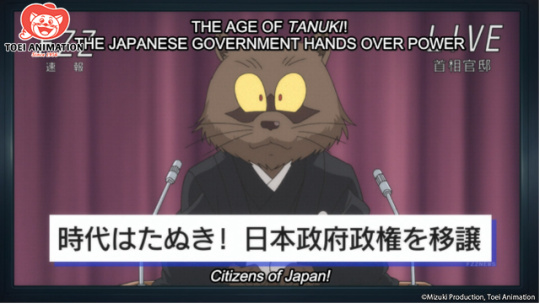
The tanuki plot world domination
The titular Kitaro himself is a half-human, half-yōkai one-eyed boy who travels between the human and spirit world to resolve monster-of-the-day conflicts with his friends. Although Mizuki’s Kitaro as we know it began serialization in 1960, Mizuki originally received permission to re-imagine the character from Masami Itō, who first created Kitaro in the 1930s in pre-war Japan. The most recent 2018 anime series re-establishes Kitaro in a modern setting, yet still adapts many of the most iconic stories. Characters such as Neko-Musume, based on volatile cat spirits called bakeneko, are updated with new designs while Kitaro mostly remains the same. Mizuki’s older creations, such as the jubokko (vampire tree) yōkai, are still featured alongside a new re-imagining of the “wall monster” nurikabe — inspired by the discovery of an Edo manuscript in 2007. The appeal of Kitaro isn’t so much the meticulous adherence to yōkai mythos, but rather Mizuki’s continual improvisation of the folklore-informed monster-making tradition.
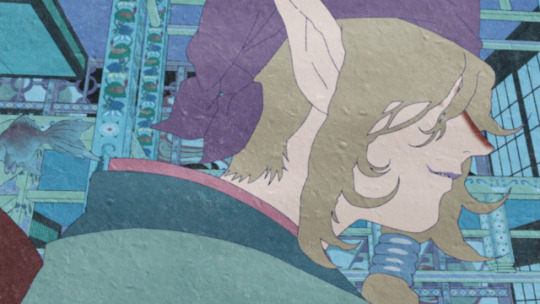
The Medicine Seller
Beyond Kitaro, other series, such as 2006’s Mononoke, dedicate entire storylines to a wider category of ayakashi (sea-bound yōkai) and funayūrei (boat spirits) written by none other than Chiaki J. Konaka. Later episodes feature bakeneko and nue (chimera monsters), but with a twist. The term mononoke itself refers to a variety of yōkai specifically referring to vengeful spirits possessing people or things. When it comes to series taking a more “fantastical” approach to folklore, both Mononoke and Kitaro thankfully never dissolve into simple rogue galleries of monsters — their (mostly) human protagonists largely remain the heart of their chilling saga.
Horror-Historical: Osamu Tezuka’s Dororo
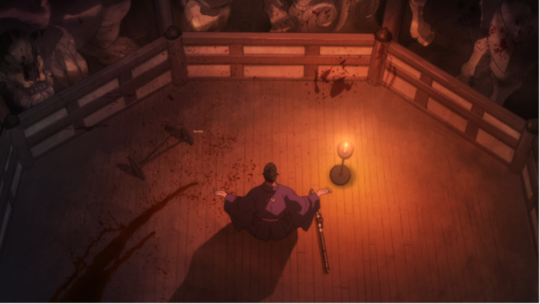
Lord Kagemitsu Daigo makes a pact with the demons (Source: Amazon)
In Anime and Its Roots in Early Japanese Monster Art scholar Zília Papp comments Mizuki’s “Kitaro characters became synonymous with yōkai in the postwar period, continuing to the present time” compared to his peers like Tezuka. But if Kitaro made yōkai big in comedic manga, then Tezuka’s short-lived Dororo manga drove this interest toward the historical context of the Sengoku Period, or the “warring states” era of feudal Japan.
Rather than depicting spirits as purely whimsical mischief-makers, Dororo’s inciting event is a feudal lord of the fictional Daigo clan forging a pact with 48 demons, who persist to hunt his son long after the pact is forged. In his feature The History Behind Osamu Tezuka’s Dororo, Marco Oliveros comments that by depicting yōkai during this period, Dororo draws inspiration from actual shifts in changing Buddhist attitudes toward these entities:
“One of the foremost examples of this change to yokai is the tengu. Wrathful and demonic, the avian creature tricked and assaulted Buddhist clerics and civilians alike, becoming characterized as the sworn enemy of Buddhism. The apparent hostility of these yokai to Buddhism makes their dark deals with Dororo's Daigo an unsurprising turn of events for the Sengoku Jidai era.”

The Amanojaku is captured and sealed inside a Buddhist temple (Source: Amazon)
Matt Alt’s 2016 translation of Japandemonium Illustrated: The Yokai Encyclopedias of Toriyama Sekien describes the tengu (mask-wearing entities usually depicted as half-man half-bird) as “deeply associated with the religion of Shugendō,” which originated during the Heian period; however they were depicted very differently in major Buddhist sects of the same era. Unlike solely “fantastical” stories of the supernatural without much acknowledgment to historical context, Dororo is interested in this context regarding capricious attitudes of spirits of people alike. Impressive malevolent entities such as kyūbi (nine-tailed foxes) also fight against Dororo’s protagonist, Hyakkimaru, typical of supernatural jidaigeki (period drama) horror stories set in feudal Japan.
However, Dororo also features lesser entities such as amanojaku (tiny, goblin-like demons). According to the influential illustrated encyclopedia Wakan Sansai Zue compiled by Sekien-predecessor Terajima Ryōan, amanojaku and tengu were described as paired descendants of the evil goddess Amanozako (literally "tengu god"). According to scholar Haruko Wakabayashi in The Seven Tengu Scrolls: Evil and the Rhetoric of Legitimacy in Medieval Japanese Buddhism, tengu were symbolically invoked in inter-personal and religious feuds amongst Buddhist sects during the Heian period. The amanojaku depicted in Dororo is minor. But with a (simplified) understanding of its affiliation with tengu’s pre-Heian origins and its subsequent disavowal by influential Buddhist sects, Dororo's amanojaku cameo is an undeniable nod toward its theme of “old ways” impacted by a "new" institutionalized status quo.

Hyakkimaru battles the nine-tailed fox spirit in its spectral form (Source: Amazon)
While the nine-tailed fox spirit is flashy, Dororo’s amanojaku ends up pathetically sealed inside a Buddhist temple. Ironically, the amanojaku trapping scene pans from the top of a Buddhist statue, ending with the cartoonish amanojaku crushed underneath to visually imply its irrelevancy. Dororo is a story about the cultural and religious tensions brewing during this violent episode in history — making Hyakkimaru’s journey one that doesn’t simply depict supernatural folkloric tradition in stasis, but as something always under complicated socio-political stakes.
Modern Ghoul School: Ghost Stories & Bakemonogatari
What do you do if you can’t solve your evil spirit problems with a sword? For the most part, classics like Kitaro and Dororo take place in the past, or at least worlds very unlike our own. A traveling demon slayer never has to deal with student council or smartphones.
In a previous article, From Bakeneko to Bakemonogatari, I discussed all the possible lineages of the catgirl character archetype. In that piece, I claimed one of the more accurate representations of the bakeneko today was Bakemonogatari’s Tsubasa Hanekawa’s cat spirit-possessed alter-ego. It’s not simply because she is a supernatural catgirl, but rather her portrayal was obviously informed by the wider context of pre-existing bakeneko mythos. Is it possible for a “modern-day” series to tackle yesterday’s folktales while still preserving the uncanniness of the past?
The spirits possessing Bakemonogatari’s cast, referred to as “oddities,” all nearly function like vengeful mononoke spirits. For example, Bakemonogatari’s first arc, Hitagi Crab, features a crab “oddity” haunting classmate Hitagi Senjougahara. The existence of heikekani (face-shaped crabs allegedly the spirits of drowned Heike warriors from the Sengoku Period), might be a parallel, considering the arc’s theme of unresolved conflict. Another arc, Suruga Monkey, features an “oddity” taking the form of a beastly paw growing on classmate Kanbaru Suruga’s arm. Senjougahara and Suruga's crab/monkey relationship can be read as alluding to the well-known Buddhist tale “The Monkey and the Crab.” According to The National Gallery of Art on its 2019 The Life of Animals in Japanese Art exhibit, the monkey and crab are usually depicted as friends, then compete until they either make amends or resolve their conflict. Often the subject of artistic interpretation, it’s no surprise this tale found its way into anime as a metaphor for teen drama.

The kids scan a talisman and e-mail it to exorcise internet demons. Yes, this really happens.
In comparison, the 2000 series Ghost Stories is best known to English-speaking audiences for being an edgy comedy. However, its original source material, a book series titled Gakkō no Kaidan (School Ghost Stories), is more akin to a heavily researched Goose Bumps. Written by folklore scholar Toru Tsunametsu, the series showcases various urban myths and monsters, most famously “Hanako” a ghost girl who haunts school bathrooms. A 2014 NPR piece describes the most popular version of Hanako being a schoolgirl in WWII “using the bathroom when a bomb fell on top of the building.” Although Hanako gained enough popularity from the books to warrant her own spin-off anime series in 1994, she only makes a handful of cameos in the 2000 series. Entities like the previously mentioned amanojaku also appear, alongside shinigami (death gods) depicted in many other anime.
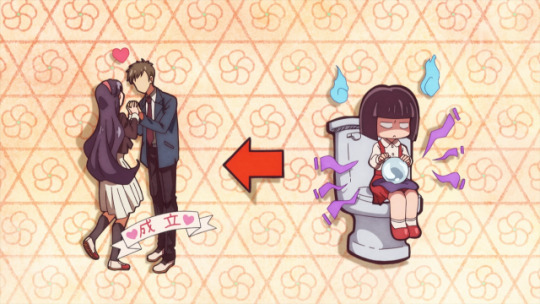
How to channel your ghost powers for success (Source: Funimation)
Hanako, because of her relatively modern backstory, is just as ubiquitous. Versions of Hanako appear in an episode of the 2018 Kitaro and most recently in the 2020 series Toilet Bound Hanako-kun. Tsunametsu currently edits the Folklore Society of Japan’s official academic journal, no doubt a testament to his priceless contributions to folklore representation in anime.
Who You Gonna Call?
There’s no way to tell the same ghost story twice. With such a layered history, contemporary anime have a nearly endless well of folkloric material to pull from. Recent series like the hit Demon Slayer: Kimetsu no Yaiba and Toilet Bound Hanako-kun prove that fans will never get enough of the supernatural, just as long as things stay fresh.
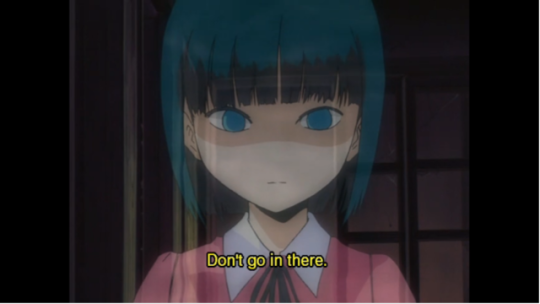
Hanako politely warns the ghost-hunting kids
Long live artistic liberty and specters trying to watch you pee.

Blake P. is a weekly columnist for Crunchyroll Features. His twitter is @_dispossessed. His bylines include Fanbyte, VRV, Unwinnable, and more. He'd like a tiny yōkai cat.
Do you love writing? Do you love anime? If you have an idea for a features story, pitch it to Crunchyroll Features!
By: Blake Planty
25 notes
·
View notes
Text
Part III (1/2): chapters 19-25
Vs. Mahito Arc
Chapter 19 (aka why this blog exists)
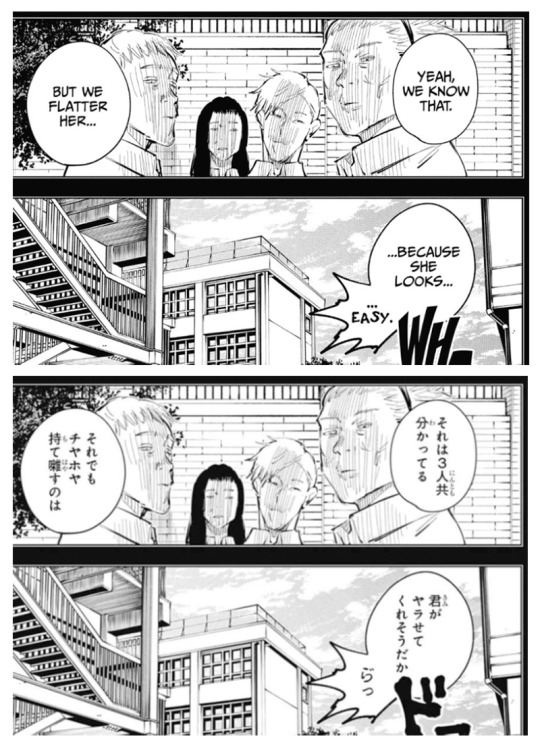
J:”Yeah, we know that. But we flatter her because she looks easy.”
⇒ ”And the three of them know it as well. But they flatter you exaggeratedly anyway because they think you’ll let them do you”
Actually Junpei’s lines.

J:”I can’t believe people like that go to my school.”
Not incorrect, I just want to point out that Junpei didn’t just say “people”, the word he used is “race” (人種), which implies he doesn’t see them as the same kind of human he is.
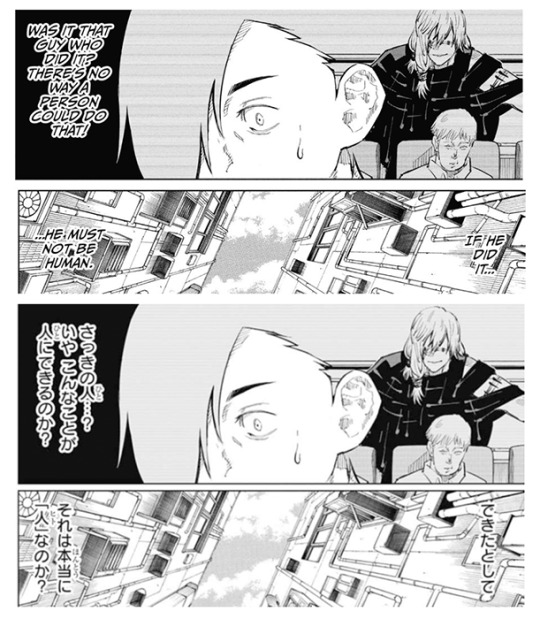
J:”Was it that guy who did it? There’s no way a person could do that! If he did it, he must not be human.”
⇒ “Was it that person just now? No, would such a thing be even possible for a human being? And if it was, would they really be a ‘human being’?”
Overall correct but the flow was different. Mind you, 人 can be translated both as “person” and “human being” (among others) depending on the context. Imo this captures the nuance better but YMMV!

N:”I’m here to identify the truth and uphold the law. There was a time when I thought the society had the same goals”
⇒ ”Adapting to the facts [in front of you] and managing yourself accordingly. That’s who I am. There was a time where I mistakenly believed society operated on the same basis.”
This was really hard to translate, especially since the phrase Nanami uses here is rather formal language. I actually checked the official anime subtitles for this one and they went with “I adhere to the facts and judge on that basis”, which I guess is close enough? I’d probably go with it as well if not for the fact that he doesn’t just say 律する but 己を律する (己/onore = I/me in humble language).
Seems like the exact meaning of the phrase is difficult to understand even for Japanese people - there are whole articles out there breaking down the meaning and giving examples of how to implement it in life 8D Anyway, the simplest explanation is “to control yourself”, with further nuance of “enforcing rules on yourself in order to achieve a goal”, “restricting your desires and impulses by your own will” etc.
Thanks a lot, Gege.
Btw, Ino, who respects Nanami greatly and considers him a mentor, actually uses the same phrase, word for word, in ch. 95! (事実に即し、己を律する) That’s how important it is. Also, continuity!

Y:”Let’s do it!”
N:”There’s no need to get excited”
⇒ Y:“Let’s go all out!!”
N:”No, if moderate’s enough, let’s just do it moderately”
They both used descriptors for just what kind of intensity they should approach the mission with. Imo, an important distinction because after they learn the full extent of the situation, Nanami takes back his words from this moment and agrees with Yuuji, going as far as to use the same words Yuuji did here.
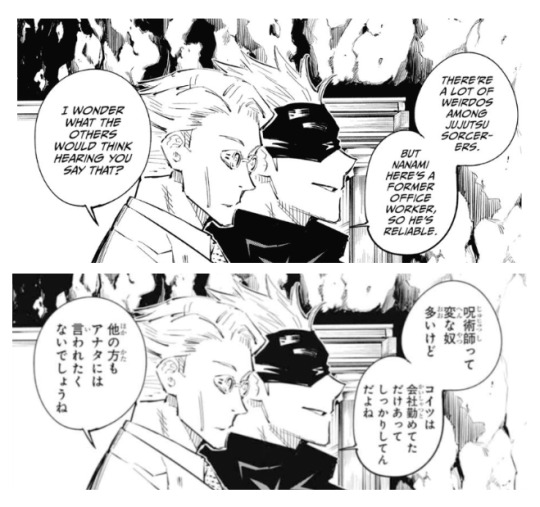
N:”I wonder what others would think hearing you say that”
⇒ “I’m sure the others wouldn’t want to hear that from you [of all people]”
So not so much “don’t be rude” as “dude, you’re the weirdest of them all”. Emphasis mine.
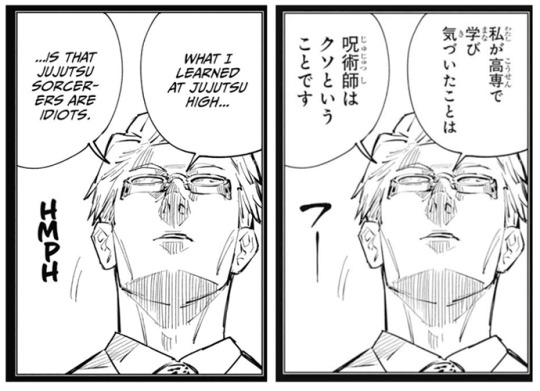
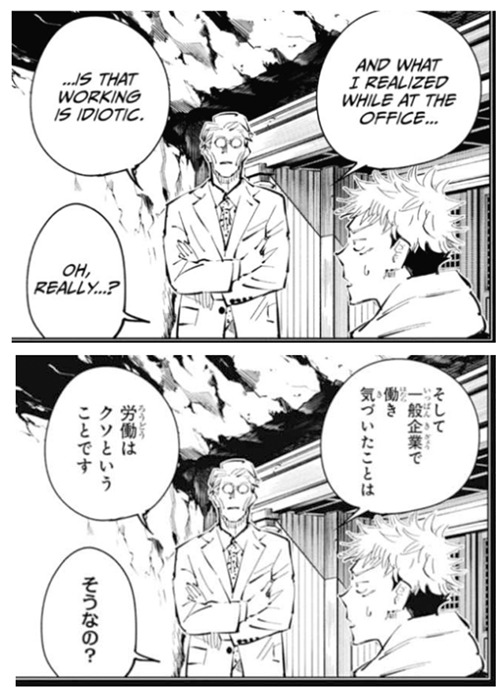
N:”What I learned at Jujutsu High is that jujutsu sorcerers are idiots”
& “What I realized while at the office is that work is idiotic”
He actually says “shit” both times lol. If it was just the humour that suffered here, it still wouldn’t be too awful but unfortunately it’s not just that. The “sorcerers are shit” line gets recalled when Nanami’s facing death, trapped in Mahito’s domain, which makes it pretty damn important. It gets translated yet differently by the official release then, too, which further damages continuity I believe Gege intended for this.

”So I took the lesser of two evils. Nothing more, nothing less”
⇒ “If both are shit, then I just chose the one I’m more cut out for. That’s all as far as the reason for my coming back is concerned.”
I mean, if we realllllly insist on watering down everything that Nanami says (as JJK translators apparently did), then the basic meaning was conveyed but the original wording and nuance was closer to what I proposed.

N:”Prove to me that you can be useful in spite of the demon Sukuna inside of you”
⇒ “Give your best to prove that you’re useful despite carrying the bomb that Sukuna is.”
Considering how 2 pages later Nanami tells Yuuji that he’s not the one Yuuji should be proving himself to, it’d have been weird if this is actually what he’d said, wouldn’t it. But Nanami’s nothing if not reasonable, so that wasn’t the case.

Y:”I’m weak and useless. I’ve been hearing a lot of that these days”
⇒ “That I’m weak and useless... I’ve been realising that to a painful extent these days”
“I’ve been hearing it” would imply that someone was actually saying it either to Yuuji himself or to others which he was aware of. (I mean, other than Sukuna.) The original wording doesn’t really hold such connotation.
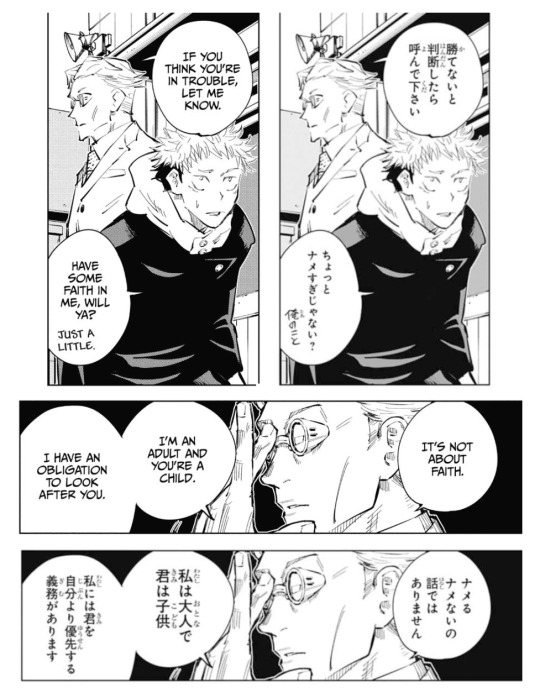
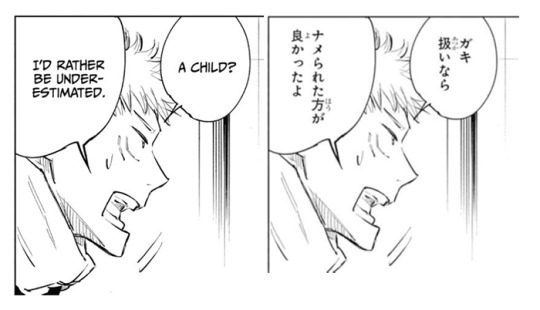
N:”If you think you’re in trouble, let me know”
Y:”Have some faith in me, will ya? Just a little.”
N:”It’s not about faith.(...)”
Y:”A child? I’d rather be underestimated”.
⇒ N:“If you decide you cannot win, please call me.”
Y:”Aren’t you underestimating me too much?”
N:”This is not about ‘underestimating’ or ‘not underestimating’.(...)
Y:”[Even] being underestimated would’ve been better over being treated like a kid.”
I guess the translators wanted to avoid saying “underestimate” 3 times in a row? Albeit that’s what the original does.
More importantly though!!
N:”I’m an adult and you’re a child. I have the obligation to look after you”
⇒ “(...) It’s my obligation to prioritise you over myself.”
Quite a different nuance, right. Not just “I have to look after you” but “your well-being [life] takes priority over my own”.
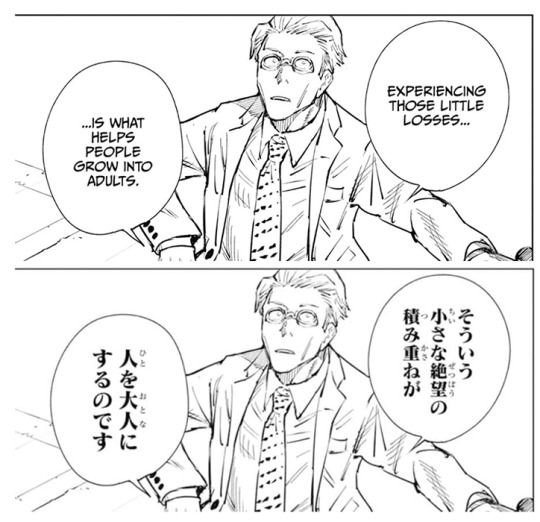
N:”Experiencing these little losses is what helps people grow into adults”
⇒ “It’s the accumulation of such small despairs that turns people into adults”
Not that wildly different but despairs (hopelessnesses) >>> losses, y/y. Also “helps” made it sound more positive when it’s both a poignant and at the same time dry statement.
Chapter 20
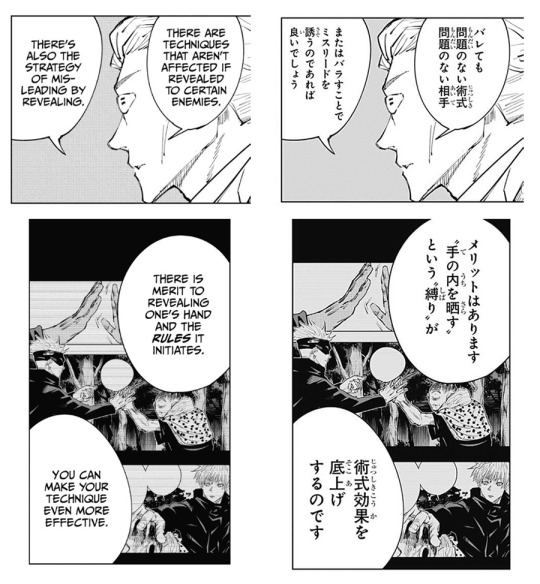
N:”There are techniques that aren’t affected if revealed to certain enemies”
Those two feel more like separate examples to me. I.e. that there are techniques that aren’t affected if revealed, and there are some enemies that you can afford to reveal your technique to. Could apply simultaneously but don’t necessarily have to, if that makes sense?
“There is a merit to revealing one’s hand and the rules it initiates. You can make your technique even more effective.”
⇒ “It has its merits too. The ‘binding’ of ‘revealing one’s hand’ amplifies the effectiveness of your technique.”
Wild lost “binding” appears! Like I indicated before, it’s the lack of consistency to translating terms that are consistent in the original, that has negatively affected the fans’ ability to understand the basics of jjk techniques and world-building.

[Explaining Yuuji’s divergent fist]
GJ:”But it’s a lot easier said than done for anyone else.”
⇒ “It’s not something that can be easily done on purpose”

N:”His physical strength is superhuman. The impact of his hit doesn’t have incredibly strong energy, but it’s still about 20% more than a normal sorcerer. That means his delayed hit comes from his main source of cursed energy. It must be quite annoying for those on the receiving end. Such potential. If he’s able to go out all and combine his full physical strength with a cursed technique…”
⇒ “(...) The initial impact contains little cursed energy but it still achieves 120% of an average sorcerer. And then the actual cursed energy hits with a delay. For those on the receiving end it must be more unpleasant than one could imagine. And he’s got potential for growth, too. If he becomes able to add 100% of cursed energy to a 100% body…”
Uhh, this was a tricky one because on the first read it doesn’t seem that terribly wrong but when you read the original carefully, you realise this and that got lost in translation. My version should be closer to the original meaning.
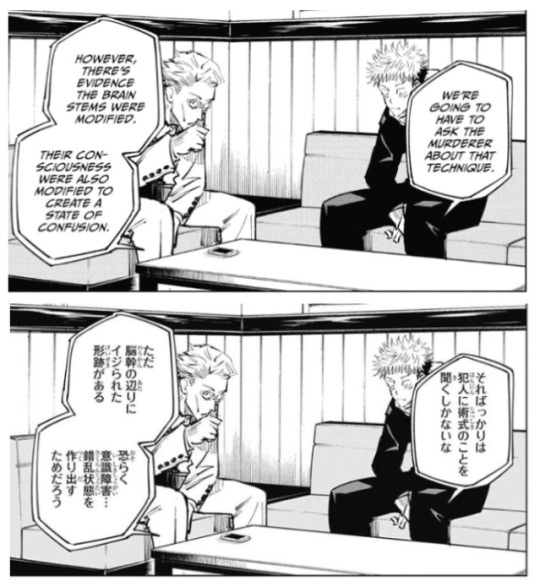
I:”We’re going to have to ask the murderer about the technique”
⇒ “That’s just something that you can’t know unless you ask the offender about their technique”
Obviously Ieiri wasn’t suggesting to literally ask the murderer.
“However there’s evidence the brain stems were modified. Their consciousness were also modified to create a state of confusion”
⇒ (...) This was probably done to create a disturbance of consciousness... a state of mental confusion”
Slightly different nuance for this one.
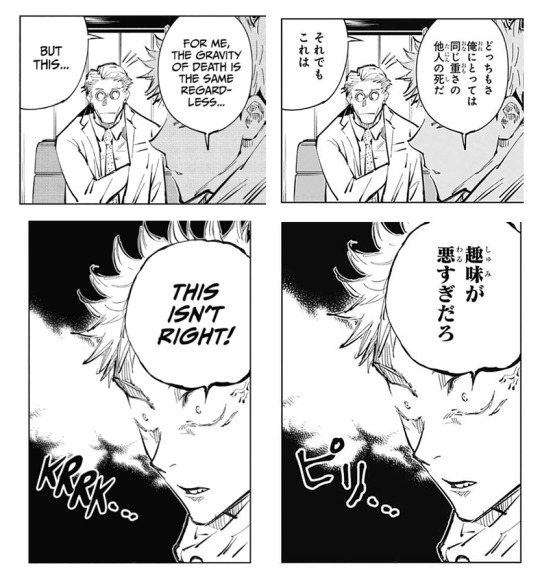
Y:”For me, the gravity of death is the same regardless. This isn’t right!”
First sentence is mostly correct but it should’ve been “the gravity of death of another person” (emphasis mine).
Second sentence sounds too mild for what is actually Yuuji being super mad specifically about the way those people were killed? The phrase he uses means something like "This is just in way too poor taste”, “way too vulgar” etc. I guess if you went for a less literal translation, you could say “just too disgusting”/”revolting”.

N:”This matter won’t be taken care of so easily. Let’s do it”
⇒ “Looks like ‘moderately’ won’t be enough here. Let’s go all out.”
This is the instance of Nanami retracting his words and backing Yuuji up by borrowing his own words that I mentioned earlier!
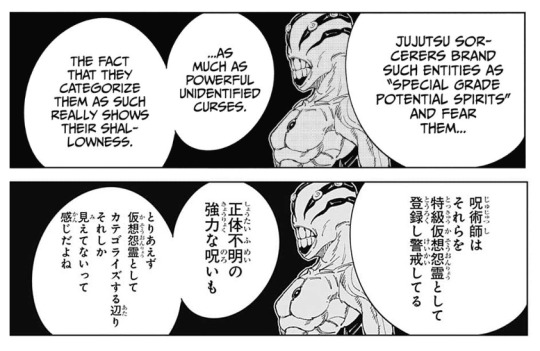
M:”Jujutsu sorcerers brand such entities as “special grade potential spirits” and fear them as much as powerful curses. The fact that they categorize them as such really shows their shallowness”
⇒ “Jujutsu sorcerers register them as “special grade potential apparitions” and remain on alert against them [on alert for their appearance]. The same applies to powerful unidentified curses. That they categorise them as ‘potential apparitions’ just shows how little they truly see.”
It’s not that sorcerers fear them per se but that they (most likely) monitor them and are on guard against them. When followed up by the “what people truly genuinely fear are natural disasters [forces of nature]” conversation, it becomes clear that what Mahito scorns sorcerers for is their short-sightedness for thinking all powerful curses must be born out of people’s imagination, ~urban legends~ etc.

[Junpei asking what Mahito was born from]
M:”Thanks to the hatred spewed between people I was born”
⇒ “I’m a curse born out of the fear and hatred people harbour towards [other] people"
or even
“I’m a curse born out of people hating and fearing people”
Again a quite different nuance. They really shouldn’t have edited “fear” out.
Chapter 21

J:’Don’t you think that whoever first said, ‘The opposite of love is not hate, it’s indifference’ must be rotting in hell? There’s no way hating people is better than feeling indifferent towards them.”
⇒ “(...) There’s no way that approaching others with evil intentions is better than not interacting [with them] at all”
The first sentence is mostly fine although the original doesn’t include the “is not hate” bit, it only says “the opposite of love is indifference”. The second part is quite different. After all, hating doesn’t necessarily imply there’s any action taken.
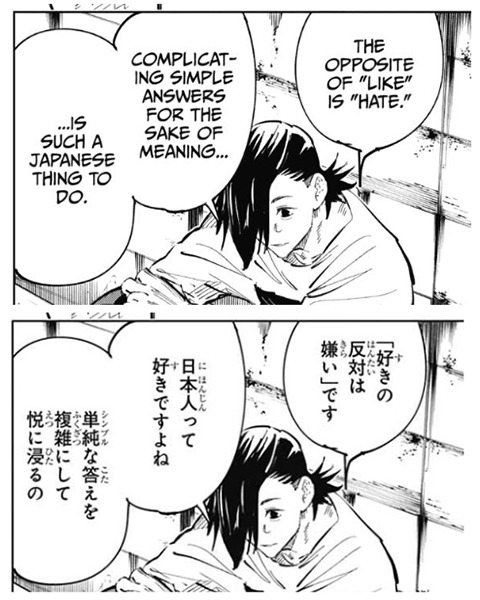
“Complicating simple things for the sake of meaning is such a Japanese thing to do”
⇒ “Japanese sure love it - complicating simple answers and gloating in it”
I didn’t like the “for the sake of meaning” bit, imo it’s over-interpreting.
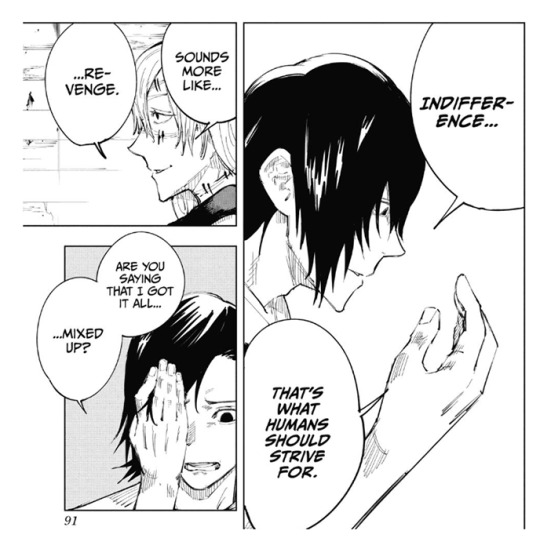

J:”Indifference. That’s what humans should strive for.”
M:”Sounds more like revenge”
J:“Are you saying that I got it all mixed up?”
Junpei’s first line here is fine although interestingly enough he puts it as “a virtue humans should strive for”. Then it’s
⇒ M:“And yet you wish for revenge”
J:”Are you trying to say I’m contradicting myself?”
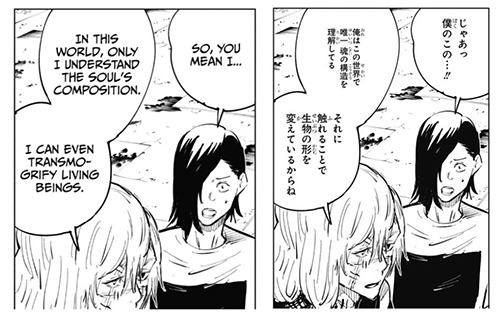

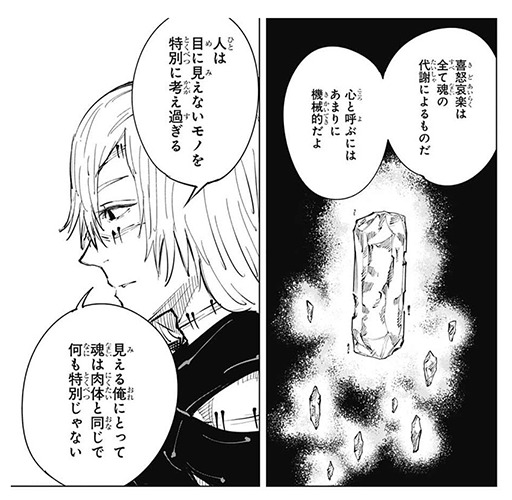
M:”In this world, only I understand the soul’s composition. I can even transmogrify living beings. Emotions come from the soul. It’s too simplistic to call it ‘heart’. People overthink the things they can’t see. (...)”
⇒ “In this world I’m the only one who understands the soul’s composition. After all, I change the shape of living beings by touching it. Emotions are products of the metabolism of the soul. It’s altogether too mechanical [of a process] to call it a heart. People assign too much value to things invisible to the eye.(...)”
Last one is literally “consider ‘special’ way too much”, simpler wording than what I went with but I tried to make it more legible.
The “metabolism of the soul” phrase is especially vital because Junpei throws it at Yuuji almost word for word when confronted by him at the school after his mother’s death.
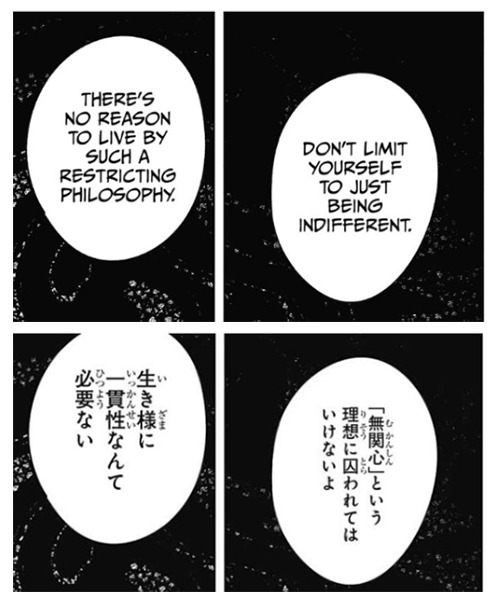
More philosophy lessons from Mahito-sensei \o/
“Don’t limit yourself to just being indifferent. There’s no reason to live by such a restricting philosophy.”
⇒ “Don’t allow yourself to be shackled by the ideal called ‘indifference’. There’s no need for there to be consistency in one’s way of life.”
Mahito actually takes the “is ‘consistency’ necessary” stance a few times in the manga, including when he and Getou squabble about the relationship between the body and the soul in Shibuya. A pity about the mistranslation here.

“I support everything you represent, Junpei”
⇒ “I’ll affirm your everything, Junpei”
Imo the act of supporting and the act of affirming while similar aren’t one and the same, hence the change.
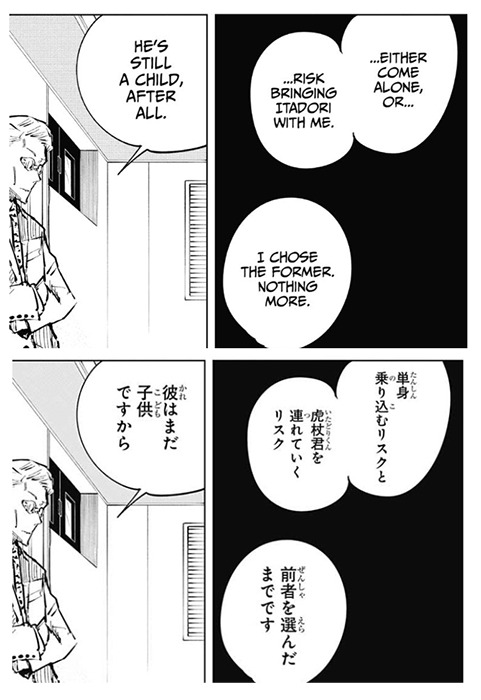
N:”Either come alone, or risk bringing Itadori with me. I chose the former, nothing more. He’s still a child, after all.”
⇒ “The risk of venturing [into the enemy’s territory] alone, or the risk of bringing Itadori-kun with me. I simply chose the former. He’s still a child, after all.”
Idk, I feel like cutting out “the risk” from the first option makes Nanami sound more callous? Like Yuuji’s a liability and going by himself is a sounder option. Whereas, it was actually him weighing two risks against each other and deciding that potentially endangering Yuuji is the one he can afford less.
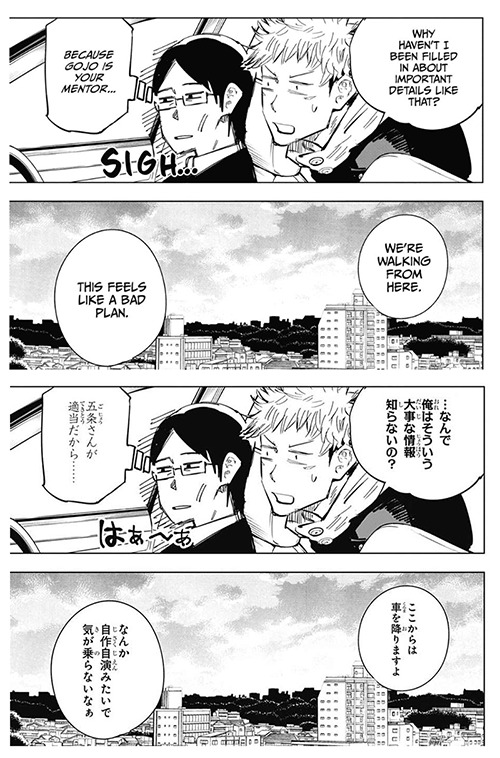
[After Yuuji asks why he doesn’t know important jujutsu related stuff.]
I:”Because Gojou’s your mentor.” ⇒ “it’s because Gojou’s ...”
He actually uses a lovely adjective to describe Gojou, which can mean a plethora of things, including: irresponsible, sloppy, lazy, unreliable, careless, perfunctory etc. etc.
Ichiji? Not a member of Gojou Satoru Fanclub.
Y:”This feels like a bad plan”
⇒ “This feels so staged, I don’t like it.”
Lit. “play [perform, read] one's own work”. I think what Yuuji might’ve meant here was that the plan felt dishonest? Second sentence could also be “I don’t feel up for it.”
Chapter 22
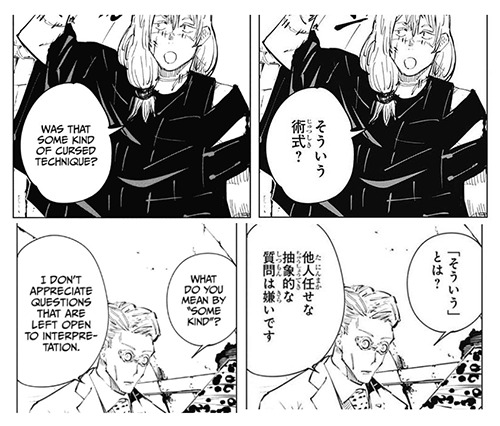
M:”Was that some kind of cursed technique?”
N:”What do you mean by ‘some kind’? I don’t appreciate questions that are left open to interpretation”
⇒ “(...) I hate abstract questions that put the whole burden on the other person”
Lit. “that leave it to others”. Other than Nanami being more straightforward with “hate”/”dislike”, I think this was him expressing he doesn’t like people who don’t even try to think for themselves and immediately demand answers from others instead.
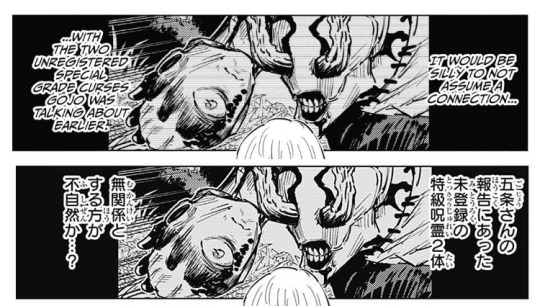
“It would be silly to not assume a connection(...)”
⇒ “It would be more unnatural not to assume a connection(...)”
Different wording (unnatural instead of silly), which imo affects Nanami’s characterisation.
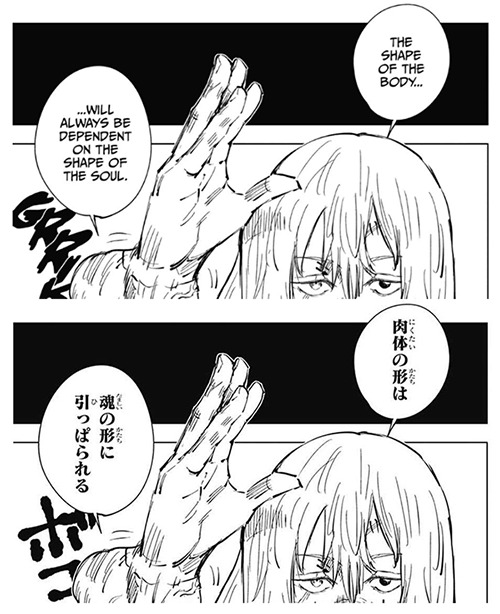
M:”The shape of the body will always be dependent on the shape of the soul”
This sounds a bit too passive and generic? Closer to “The shape of the body gets pulled along by the shape of the soul”, which is literally what Mahito’s technique does.

I’m heavily paraphrasing but!
magazine raw scans: ”it's 6:30 PM now and I started working at 11 AM, so I'm going to finish by 7PM no matter what”
official English release:”it's 5:30 PM now and I started at 10, gotta finish by 6”
The time change is so random, I wonder if Gege simply changed it themselves for the volume release. Maybe to bring it closer to the common office job times? Typical Japanese work day at the office begins at 9AM and lasts 8h + 1h break (completely unpaid but compulsory). I guess if Nanami skipped the break then working 10AM-6PM would make it exactly 8h?
The biggest mystery of jjk.
Chapter 23
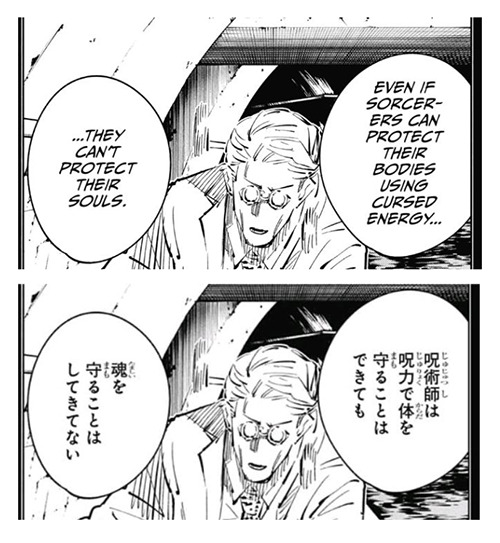
M:”Even if sorcerers can protect their bodies using cursed energy, they can’t protect their souls”
⇒ “Even if sorcerers can protect their bodies using cursed energy, they [just] aren’t used to protecting their souls”.
So it’s not that they “can’t” as in “are incapable of” and more that there’s never been the need, so they never learned how and aren’t used to doing it. As proven by Yuuji later it’s not impossible.

M:”Overtime? He restricts himself based on time! He was limiting his power until now!”
⇒ “Overtime work? A ‘biding’ based on time! He was suppressing his power by himself until now!”
Another instance where “binding” as a term makes its appearance (it even uses quotation marks) but wasn’t properly denoted by the translators.
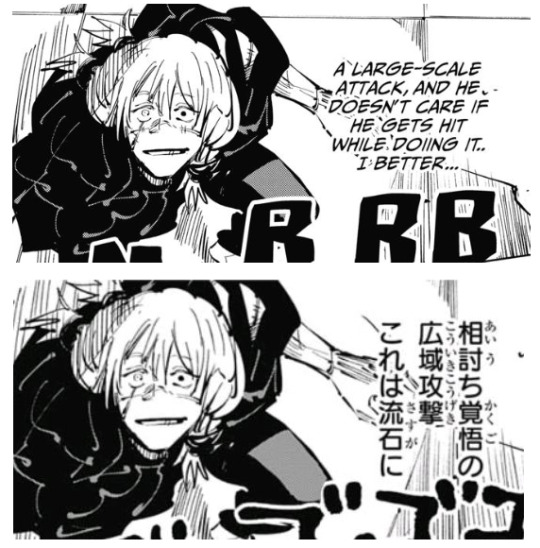
M:”A large-scale attack, and he doesn’t care if he gets hit while doing it!”
⇒ “A large-scale attack [done] with the resolve of [potentially] getting killed along with me!”.
The phrase Mahito uses here is 相打ち, lit. “killing [hitting] each other at the same time”. Also, “doesn’t care” and “is prepared/has the resolve” are quite different, aren’t they.
Chapter 24

J:”The way a perfectionist is willing to lay everything out there is beautifully portrayed”
⇒ ”The change in emotions [leading up] to a perfectionist abandoning everything is properly portrayed here”
I’m including this because knowing Gege, it’s not just simple movie talk, and it’s actually foreshadowing Yuuji’s future fate or something 8D
I can’t decide if it’s “abandon” (also “throw out of the window”) or “sacrifice” because the word used can mean either. I’m leaving that to everyone’s interpretation.
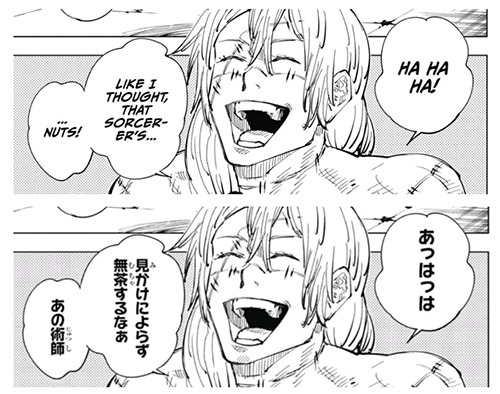
“Like I thought, that sorcerer’s nuts!”
⇒ “He doesn’t look it but he sure does reckless things, that sorcerer”
How does "he doesn't look it but (...)" even become "like I thought (...)"? He was laughing at and enjoying the contrast between Nanami's appearance/attitude and his actions/fighting.
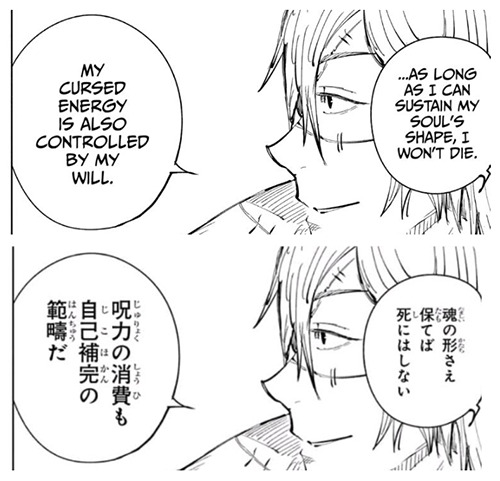
M:”My cursed energy is also controlled by my will”
⇒ “The spending of cursed energy too is among things I can supply by myself.”
I’m not entirely sure because it’s a tricky one, so take this one with a grain of salt. But the official release is definitely missing “spending/expenditure” and Mahito isn’t talking about using/manipulating his cursed energy in general but “the amount of cursed energy spent”.
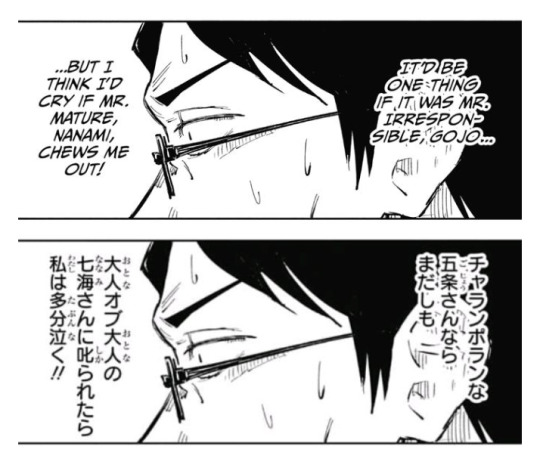
“Mr. Irresponsible Gojou” ⇒ “Devil-may-care Gojou-san”
“Mr. Mature Nanami” ⇒ “The adult of [all] adults Nanami-san”/”the adult above all adults”
I just really enjoy Ichiji and his little epithets, I guess.
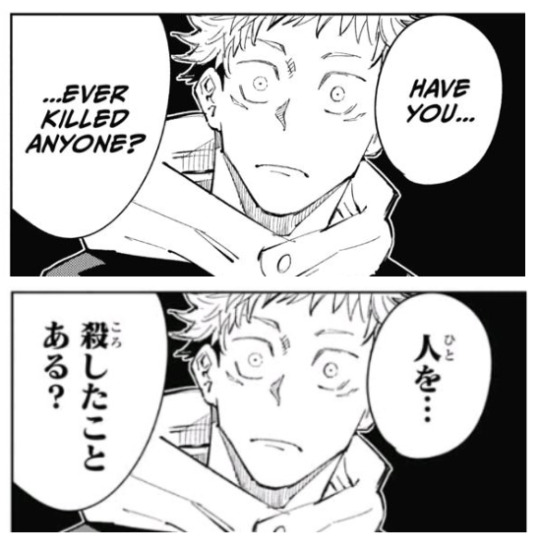
J:”Have you ever killed anyone?”
⇒ “Have you ever killed a human being/another human?”
Just putting it out there because imo there's a distinction between “anyone” and “a human being”. Especially considering how much of this arc was questioning what being a human means.
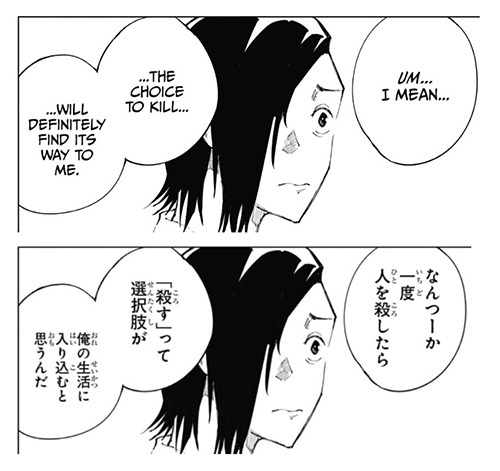
Y:”Um… I mean, the choice to kill will definitely find its way to me”
⇒ "How to put it... once I've killed someone, "killing" would become one of the possible options [to take] in my life".
Maybe the nuance was there in the official release too and I just didn't pick up on it but to me the former makes it sound more like he’s saying "I may still have to kill one day". Whereas the original seems to hold the connotation that if you do something once - even if it’s something as horrible as killing another human being - it becomes easier to do it again in the future because it's a choice you've made before, it's not untouchable anymore.
Chapter 25

[Yuuji expressing his regret over Nanami choosing to go fight Mahito alone.]
"Am I in your way, Nanamin?”
⇒ “Am I a burden [to you], Nanamin?”
A different nuance for this line.
“’My friend died but I wasn’t there because I’m a child.’ I wouldn't do that to you. That said"
⇒ "’My comrade died. But I wasn’t there. Why? Because I am a child.’ I would hate something like that" [to be put in such a position]
And this is just pure mistranslation. The whole “my comrade died but I wasn’t there because I’m a child” line is actually Yuuji painting a possible scenario (he does it with short sentences but the speech is overall polite). What they translated as “that said” was actually a follow-up to that scenario and could be translated as “something like that”.

N:”Being a child is not a bad thing”
⇒ “Being a child is in no way a crime”
I wanted to point this out since the original word’s most common meaning is actually “sin”, which is significantly heavier than just “not a bad thing”. Could also go with a milder “is not something to feel guilty about” here I guess.
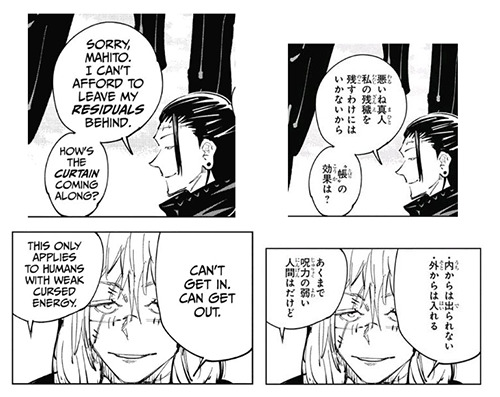
G:”How’s the curtain coming along?”
M:”Can’t get in, can get out. This only applies to humans with weak cursed energy.”
⇒ G:”What’s the effect of the ‘curtain’?”
M:“Can't get out from the inside, can get in from the outside. (...)”
Literally the opposite for the curtain’s effect. Emphasis is Gege’s, too! Also Getou’s question was actually about how exactly the curtain in question would work, and not just how it was coming along.
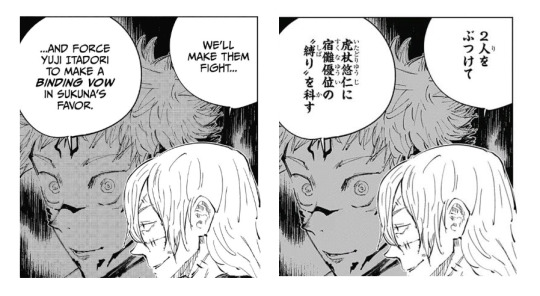
M:”We’ll make them fight and force Yuji Itadori to make a binding vow in Sukuna’s favor”
Just to reiterate, whenever “binding vow” appears, it’s actually just “binding”.
[to part iii (2/2)]
[to part iii (2/2)]
101 notes
·
View notes
Text
The Green Knight (2021)
(CONTAINS SPOILERS)
The Green Knight (2021), with its excellent cast and feast of visual storytelling, does cut a pretty trailer, but it’s hardly the adaptation we’ve all waited nearly 2 years to see. Rather on the slow side, there is plenty of breathing room (often to excess), but often feels wanting. The performances are well-played, albeit terribly subdued, which create interludes that feel tedious. Dev Patel has proven himself time and again that he has the capacity to play a nuanced lead, and he does well here, but it is the side characters that break the monotony and steal the show, most notably Joel Edgerton (Lord), Erin Kellyman (Winifred), and Barry Keoghan (Scavenger).
David Lowery’s “adaptation” explores the journey of an untested and somewhat undeserving not-quite-Sir Gawain, a far-cry from our Hero in the text, more akin to Prince Hal. This change adds elements to the character with which an audience might more easily identify, and should make this a coming-of-age tale, as well as a moral one; though, this film fails as both.
As a coming-of-age tale, Gawain never quite gets there, and it almost doesn’t matter if he does, because it's not really his tale at all. Nor is this film about morality, not even as a cautionary tale. Perhaps it's more accurate to call it an instance of ‘careful what you wish for’. Gawain doesn’t seem to know what he wants. Does he really want to be a Knight? Is this about living an honest life or living up to familial expectations, particularly your mother's? Hard to say, as many of the female characters, including Gawain’s mother (Morgause and Morgan Le Fay made one), are treated as mystery elements themselves. It’s also not clear just how far her control extends, if it has any limitations. Is there anything in this world that is true?
Perhaps we'll never know his mother's true intentions; it clearly wasn't for her son to be his own person and make his own decisions. A man simply doesn’t become a Legend without his mother’s entire fabrication of the quest, it would seem. Does Gawain feel so out of place in his own story because it’s already set out for him? Was Morgan Le Fay simply Lowery’s segue for the concept of Legend as a set path for Gawain to follow? But as such, Gawain’s tale of morality isn’t what it seems, as he doesn’t even have the illusion of choice. Or was it all just a journey back to nature, back to green? Lowery never lets us forget just what color matters most here. There’s even a fun monologue about it! Even the design of the Green Knight is just a little too on the nose; his appearance essentially being that of an ent.
About 2/3 of the way through, The Green Knight actually shows a hint of promise, but it is short-lived. In case you haven’t already lost interest with the lengthy side quests; everything turns sour at the arrival of Lord and Lady Bertilak’s castle (simply titled Lord and Lady), and what should be the bulk of our story, the “exchange of gifts” and Gawain’s true test of morality. The “exchange of gifts” is glossed over for a taste of something completely different, as it takes major liberties with not only a core part of our tale, but arguably what’s most memorable about the original. It becomes Lowery’s convoluted vision of a different sort entirely, one where Gawain seemingly refuses to take part in his own story. While possibly an interesting take in itself, it does a disservice to the text, and accomplishes nothing other than an attempt to be shocking.
There’s something richer in the “exchange of gifts” simply not explored in Lowery’s version, or the compulsive need to “subvert”, and the film is poorer for it. How can you even subvert something which you refuse to touch upon? It’s also extremely odd and honestly baffling, that in this day and age, homosexual themes and undertones would be downplayed or outright rejected (as they are here), rather than embraced and explored. Altogether, this omission seems a poor choice and a clear indication that Lowery holds little to no affection for the original text. Disregarding the “exchange of gifts”, the journey becomes something vain and hollow; perhaps intentionally, but doesn't serve anyone, least of all the story.
Following the tale’s example, the girdle (sans the accompanying scar) is the all-encompassing symbol for Gawain’s shame, but Lowery takes it a step further, in which he is so seduced by its promise of protection that he literally soils it with his lust. But this scene is so abrupt at the all too brief “exchange of gifts” (in a film that stretches everything to excess) that it seems to lack consideration and its only purpose is to disturb. The girdle furthermore becomes a symbol of his unearned and unholy life (which we’re shown), were he to continue to fail to accept his fate and his test, although this too seems superfluous. What’s interesting here is that in either scenario, Gawain remains undeserving. He is not especially virtuous, he’s not even decent from what we can see, and has failed in almost every chivalric aspect; after all, he is “no knight”. Even so, in the original, even the Green Knight can’t begrudge his lack of fidelity in this one aspect; “because you wanted to live, so I blame you the less”.
A message of The Green Knight seems to be acting out of selflessness as the only indicator of a truly good deed, with no expectation of reward. This is evident in the dismissal of the “exchange of gifts” and Winifred’s admonishment, "Why would you ever ask me that?", but this message is so muddled within the world of the film, that it’s somehow also completely out of place. After all, Gawain is rewarded in a way, with several of his trappings, which are returned to him after being stolen. Speaking of rewards for good deeds, religious themes are also notably lacking, favoring the pagan angle (as expected of A24), though which is never expounded upon. There is the decision to keep some not-so-subtle imagery of crippled Christianity; i.e Gawain’s shield (with Mary’s visage on the inside and a small pentangle on the exterior) and a cross at the Green Chapel.
Lowery gets too hung up on a confused mix of vague and painfully obvious ideas of symbolism and makes huge, unwarranted leaps. His work here reeks of self-indulgence, to the point of parody. It’s also simply never clear what anyone’s intentions are, his least of all. His ideas are so flighty and changeable that contradictions abound in the finished product (It’s clear why he needed all that extra time to re-cut). The whole thing is so nebulous that it may fool some into thinking it’s beyond their grasp, but it just reads as pretentious. The thing is, The Green Knight tries to be too many things at once, and in doing so, fails at all of them. Lowery lacks the conviction to support anything he presents and has no sense of narrative structure. Simply put, this film lacked proper direction and would have greatly benefited from fresh eyes on the script.
The Green Knight may question 'What is Honor and if it does exist, what is it worth? For even if there comes a time to prove yourself for Honor’s sake, what is it all for? “Is this all there is?”’, but Lowery drops the concept of Honor as soon as he picks it up and chooses to explore Legacy and Legend, and while it leads us on an interesting journey of interpretation, it’s very heavy-handed. It’s also difficult to answer any of these questions because Gawain is simply not worthy of anything. It’s not just that he is imperfect; he is not good and never acts out of selflessness or for the actual sake of Honor. He doesn’t know the meaning of the word. The original text asks us to stay true, true to our word and our values, in uncertainty and despite our fears (as a Good Knight should, and which Gawain ultimately is.) Lowery, on the other hand, begs us to forget the narrative, because he doesn’t know how to do it, and the search for meaning, because there is none. I’m not even sure he knows what he’s made.
Overall, though heavily burdened by its sluggish pace and lack of structural integrity, The Green Knight, at least on the surface, appears to be a somewhat earnest attempt at exploration within the fantasy/horror genre, asking a lot more questions than it answers. But while its visuals may dazzle, it’s a cold and unfeeling thing, devoid of all charm of the original tale, and can hardly be called an adaptation for many of its choices.
Source: https://letterboxd.com/avega007/film/the-green-knight/
(I wasn’t expecting to go off when I just got a letterboxd, but this film left me heated.)
#the green knight#sir gawain and the green knight#david lowery#dev patel#I really wanted to like it#but it disappointed me#spoilers
14 notes
·
View notes
Text
Higurashi Gou final thoughts pt. 1
(Spoilers go under a cut:)
Taking this by arc:
Onidamashi-hen: The best executed first cour arc by a significant margin. Probably not coincidentally, it stays the closest to the structure of the OG arc and thus keeps more of OG’s tension ratchet than the other Gou arcs. I have two main issues, and I’m pretty sure both of them can be firmly pinned on the anime staff rather than Ryukishi07 himself. First, it pulls its punch on the stealth sequel aspect. I’m not entirely sure that going for a stealth sequel was the correct decision (it’s a cost/benefit tradeoff), but if you do you’re going for the wham of the sequel reveal, and the anime undercut this by putting the Rika/Hanyuu scene at the start of episode 2 rather than the end of the arc. Second, it overdoes the final Rena fight, making it so over-the-top that it’s difficult to take seriously. Neither of these issues exist in the manga (which has a believable amount of stabbing and has the Hanyuu scene at the end of the arc where it should be), and in the former case we also have a Ryukishi07 interview indicating that this was a change requested by the anime staff, so this goes on them. (Interestingly, by way of contrast I think this approach might actually work well for the Mieruko-chan adaptation that Passione has coming out later this year.)
Watadamashi-hen: The core issue here (above and beyond fridge logic after Satokowaski-hen) is the finale, which landed like a wet fart. It both escalates from zero to 100 *way* too fast and has the worst case of “tell don’t show” in the neo-question arcs - we learn about every single dead body in the arc from Ooishi’s end-of-arc narration. That’s relatively defensible for three of those bodies, which we only learn about secondhand even in OG Watanagashi-hen (though IIRC in OG two of those bodies have foreshadowing from rumors earlier in the arc, and unless I’m forgetting something that’s absent here), but all five? Yes, keeping Keiichi locked away from the final showdown removes fridge logic issues, but you have prominent security cameras - you can at least have him see the aftermath of the showdown on the screens (and freak out because of it). Adding insult to injury, the Keiichi vs. door scenes are also so over-the-top as to damage willing suspension of disbelief. The 0-to-100 issue is harder to fix, because the one thing Watadamashi did right was put the Rika-loses-it scene as an end-of-episode cliffhanger, and “Keiichi et. al. are about to enter the Saiguden” probably wanted an end-of-episode cliffhanger as well for discussion purposes (it might have been able to get away with using the commercial break). The simplest fix is the same one @tsuisou-no-despair floated: cannibalize an episode off of another first cour arc.
Tataridamashi-hen: Amusingly, I think Gou has retained OG’s tradition of having the Tatari- question arc being the weakest question arc. As I see it there are two interlocking core issues here which boil down to the same issue. Tataridamashi-hen goes for a very unconventional method of building tension: it doesn’t, instead relying on the viewer’s realization that something bad has to be coming to do so for it (the old “that can’t be right, we’ve still got twenty minutes left in the episode” reaction I more commonly associate with things like police procedurals). The problem is that this runs into the Endless Eight lesson: even flawless metatext should not be used at the expense of enjoyability of the actual text. And while the arc got some leverage out of “when exactly is this going to diverge?”, there’s a point much like Endless Eight itself when you realize where it’s going to diverge (i.e, not until the end) and that until then you’re sitting through the same events you remember from OG. It works about as well as it did for Haruhi. (Unless you’re a new viewer, but in that case staying too close to Minagoroshi-hen has other issues.) Worse, unlike Minagoroshi-hen itself (which did something similar to build tension but a) non-source readers hadn’t seen it before so it wasn’t foregone the same way and b) you had several more episodes after the subarc for the main event) the arc ends almost immediately after this. (The simplest fix here might have been cutting down on the arc time by speedrunning Minagoroshi events, reducing the amount of time you’d have to wait. You could even have a couple of obstacles collapse faster than expected; this late in the first cour it would serve as foreshadowing for Satokowashi-hen, and would also deal with unfortunate implications concerning the village’s prejudice considering that the staff knew Satoko was going to be the culprit. Trimming an episode would also neatly solve the issue of where to get an additional episode for Watadamashi-hen from!) The good news is that the final confrontation is the best of the first cour arcs (it’s somewhat more realistic than the other two, actually not that far behind some of the more memetastic OG moments except for Teppei’s eyes, and not showing Ooishi’s rampage is forgivable given that they knew they would be actually showing it in Nekodamashi-hen), but that’s damning with faint praise.
Nekodamashi-hen: The best Gou arc. The episode 15 jump cut is the stuff of legends and the best scene in the show by a sizable margin (the one thing the director does well is black humor, it seems), while the rest of the arc isn’t as good, it’s far shorter on demerits than the rest of the show. The one really, really obvious demerit is that they really didn’t need to spend half an episode on the intestines-ripping scene (if Ryukishi07′s comments are to be believed, once again we’re pinning this on Passione), but effects on my stomach aside there are worse issues to have.
Satokowashi-hen: And here we have the other side of the coin; this is the worst Gou arc, and it’s the one spot where I’m pretty sure Ryukishi07 himself gets some of the blame. There’s a few issues here. First, the single most obvious dangling plot thread from Matsuribayashi-hen (Satoshi’s fate) is effectively dropped despite being directly relevant to the other dangling thread that was picked up (how Rika treats Satoko and vice versa); this includes missing an opportunity to show Satoko’s character arc through different responses to learning about Satoshi’s condition. Secondly and compounding, Shion is also dropped along with the Satoshi thread; AIUI this is kind of understandable given final Satoko/Shion interaction in the Matsuribayashi-hen VN (which IIRC never made it into the anime), but dropping her without explanation still leaves something that looks awfully like a plot hole since a single conversation with Shion is potentially enough to stop the events of this arc from ever happening. (”Character X had information that would have stopped the tragedy but never had an opportunity to tell anyone” is a classic tragedy trope, but you should really have a *reason* for that character never having the opportunity as opposed to just having them vanish without explanation.) Finally, there’s just the general issue that while the ending points for both Rika and Satoko are reasonable the path they take to get there just doesn’t quite add up. I can kind of get there via a combination of “blame the director” (the loops montage could and should have easily shown Satoko’s deteriorating mental condition as she watched - using interlaced cuts to her face with changes in facial expression is a classic method) and mind caulk (Rika was exaggerating for effect when she described her desire to go to St. Lucia’s as a long-time thing and it only really kicked in after Matsuribayashi-hen, Satoko originally only planned to suicide in Matsuribayashi-2 and only took Rika out with her as a crime of passion after feeling betrayed, hence the next few loops lacking her murdering Rika) but being mind-caulkable is not the same as actual good execution.
I mean, I’ve banged on this drum before, but... the basic concept works. Really well. Satoko’s abandonment issues and Rika’s treatment of Satoko are two of the major dangling plot threads from OG Higurashi (*eyes both Minagoroshi-hen and anime-only Yakusamashi-hen*). It makes perfectly good sense that the latter comes back to bite Rika, especially in a sequel literally titled “karma”. I already suspected Satoko was on the autism spectrum based on OG, her being ADHD in addition to or instead of that makes perfectly good sense given those conditions often overlap. Rika’s desire to escape the well morphing into a desire to escape Hinamizawa entirely? Sure, just present it as that. Satoko steadily losing her support network as her friends are torn away from her by changing life circumstances, then going to a boarding school that she hates, that strips the rest of her support structure for her and starts to take even her one remaining friend (her childhood friend, no less - and one that Satoko is at this point attracted to romantically in true osananajimi fashion) away from her, and then starting to snap with some prodding from a certain witch? That’s a compelling story idea! But as present it just doesn’t quite work, and that’s on the execution.
(Side note: I wonder if some of what went wrong with Gou was just the kind of production issues endemic to modern anime, amplified by the pandemic. I remember at least one comment/blog post somewhere in the wake of WEP’s issues noting some of the effects that production issues can have on an anime, and one of the things they noted was excessive slavishness to the source material as a time-saving measure; that sounds awfully similar to some of Ryukishi07′s comments about how he didn’t expect Passione to take his script quite so literally, and to my admittedly untrained eye it sure looked like there were a bunch more other animation studios than usual mentioned in Gou’s credits...)
Final score: depends on your exact rating system, but given the range I’m looking at I can’t see how I can give it any score other than 3.4/5 for obvious reasons. (Pending Sotsu, anyways. It’s possible that Sotsu will resolve some of these issues - in particular, Ryukishi07 always has struck me as the kind of author who would get a kick into baiting us into falling for the same twist twice; it’s not impossible that the apparent lack of unreliable narrators so far is a double bluff, and that could affect the “question arc” scores in particular. More on this in a forthcoming solution space post.)
10 notes
·
View notes
Text
FINALLY FINISHED NARUTO AHHHHHHHHHHHH!!!!!!!!
Honestly, and this might sound harsh, but I think I give the series overall a 6/10. Being generous, I’d say it’s maybe a 7/10, but I’m deducting one point because I’m almost positive the only reason I’d rate it that high is because despite all it’s flaws, after watching 720 episodes across two series and 10 movies, you’re just going to be attached to the characters and show regardless of how you feel about it.
I know it’s super popular, or was anyways, and I can absolutely see why, but there were just too many issues that bothered me personally. It’s frustrating because I want to like it, I really do. There’s so many elements at work here that are so just perfectly me that it’s almost weird that I don’t like it, but I don’t. Obviously I liked it enough to spend hours upon hours watching it, but I think I just kept expecting it to get better at some point, and that point never happened.
More about my issues with it below...
I don’t know how to frame this (I never do) so it’s mostly just off the cuff.
I’ll start with the easily dismissible criticisms, the movies. Obviously all but one of the movies are non-canon (and I’ll get to the canon one shortly...), and they’re made by other studios so it’s not entirely fair to criticize the series based on them. I’m far too used to this weird format from Pokemon and their non-canon movies, so it wasn’t a huge deal to me. I will say that, much like the Pokemon films, almost all of the Naruto films followed the same exact format: Naruto goes to a location we’ve never heard of before and will never hear of again and is forced to protect someone abrasive and annoying until the enemy is defeated and they become BFFs that we’ll never see or hear from again.
I’d say, in order from best to worst:
Road to Ninja - Naruto the Movie
Naruto the Movie 2: Legend of the Stone of Gelel
Naruto Shippuden: The Movie 3: Inheritors of the Will of Fire
Naruto Shippuden: The Movie - Bonds
Naruto Shippuden: The Lost Tower
Naruto the Movie: Ninja Clash in the Land of Snow
Naruto Shippuden: The Movie
Naruto the Movie 3: Guardians of the Crescent Moon Kingdom
Naruto Shippuden the Movie: Blood Prison
The Last: Naruto the Movie
Yes, you read that right. The one canonical movie I put in dead last. Originally I thought that position was reserved for Blood Prison, which offended me because of just how utterly contrived the plot was and how out of character everyone needed to act to get it moving. But somehow, The Last took last place because of just how bad of a movie it was that for some reason has the audacity to be canon. And look, I know why it’s canon. It’s where Naruto and Hinata ‘officially’ get together and it ‘explains’ some missing plot elements from the series (more on that...), so of course it’s canon.
But come the fuck on, the last movie in the franchise, the one canonical movie, the one that may or may not take place after the Great Shinobi War, I.E. the big final battle of the series, has Naruto going into the fucking hollow earth through a cave portal that takes him to the moon, which is falling because the man on the moon is an incel and hates earth? What kind of methamphetamines were the writers on for that one. The Hinata and Naruto bits were fine, but holy fuck was that plot bad. They may as well have put Naruto in a spaceship and sent him to Mars to fight Martian Shinobi, I mean if we’ve already crossed the line, why not run a marathon beyond it.
The movie was meant to explain away a one-off line made in the series, that admittedly I did sit and ponder whether or not they’d ever explain it, about the Sage of Six Path’s brother, Homura, who went to go live on the moon after they defeated their mother Kaguya. It was mentioned so briefly and only once that I thought for sure it wasn’t ever going to be brought up again. I also wondered where Byakugan came from since we’d gotten an explanation for Sharingan and Rennigan during the series, but never for Byakugan. I actually don’t mind the explanation that it came from Homura’s bloodline, I think that tracks well enough. The man on the moon bit was...odd, but when I thought of how strong Homura was, I didn’t think much of it. I actually thought he somehow was going to still be alive and he’d come down to earth after they defeated Kaguya, but that never happened.
Here’s the rub though, and one of my issues with the series as a whole, which is that the show seemed to keep writing itself into these weird corners where they’d be forced to do something completely nonsensical, purely because they were the ones who wrote them into those corners. It would’ve been simpler to just say all visual jutsu was derived from Kaguya’s power, or the Homura died so there’s no man on the moon, or that Tsunade died so Kekashi needs to become Hokage, etc. They didn’t have to write themselves into these scenarios, but they did anyway and the end result was them having to write complete and utter nonsense to rationalize why they did it in the first place.
Kekashi becoming Hokage doesn’t really make any sense, like at all. They literally bisected Tsunade during the war but willed her back to life when they could’ve just as easily killed her then and there since she’s largely irrelevant to the rest of the series after the war, and then it would’ve made more sense why Kekashi, the man who on numerous occasions said he didn’t want to be Hokage, would then be forced to become Hokage as he’d be the next strongest (eligible) shinobi after Tsunade. I feel like it was all meant to be a payoff to Obito’s dying words to Kekashi which told him to become Hokage, which even then I found myself asking why the fuck would he say that? Kekashi almost was Hokage once before and was so relieved when Tsunade woke up from her coma so he wouldn’t have to.
Also can we talk about how bad that final episode was? I mean don’t get me wrong, it was cutesy as fuck and actually brought a tear to my eye (when Naruto asked Iruka to be his dad I fucking lost it, I won’t lie), but they cut it off before the wedding? Before the aftermath? Before he becomes Hokage? Like I understand Boruto exists, but I don’t feel like that’s a justifiable excuse for ending your long-running series on merely the assumption that he’ll become Hokage in the future. Maybe if the show was a whole 500 episodes shorter I’d be comfortable with it ending on a vague, yet hopeful ending, but when I’ve spent fuck knows how many hours on this series you bet your ass I’m expecting some mother fucking payoff.
Also do not even get me started on Sasuke. What. The. Fuck?!?!? My guy literally just sends a note via carrier pigeon to the wedding? That’s it? Did I just fucking hallucinate the last 720 episodes or wasn’t Sasuke supposed to be like the second main character??? The absolute absurdity.
This isn’t even much of a comparison because it’s so much shorter than Naruto, but it’s all I got in the moment, but imagine if at the end of Return of the Jedi, Han Solo just decides to fucking dip. He’s just not there. He and Chewie hopped into the Millennium Falcon the moment the Death Star was destroyed and just dipped. No longer in the movie, just gone. Didn’t say anything to Luke or Leia, just up and left. That would be insane.
It’s even more offensive knowing him and Sakura end of together. My. Fucking. Gods. This has been the relationship I’d been dreading since the start when it became abundantly clear they weren’t doing even the barest minimum to actually establish a relationship between them. As it is, when I watched The Last, I thought to myself: “Well, Naruto and Hinata’s relationship hasn’t been the most well-developed relationship I’ve seen, but it’s still leagues better than whatever hatchet job they’re going to pull to convince me Sasuke and Sakura end up together”. We didn’t even get the hatchet job. That’s just how little of a shit they gave. They did not even bother pretending to give any explanation as to how I’m supposed to believe they end up together. I’m quite literally just supposed to believe it because I know it will happen. There’s no rhyme or reason to it, it’s just something that is and therefor I must accept it. Absolutely ridiculous. As it stands, the show gave us more reasons why Sakura and Lee should end up together than they did for her and Sasuke. Fuck, I’d even buy Sakura and Inu before I’d buy Sakura and Sasuke.
I could go on, I really could, but it’s late and I’m just looking forward to putting this behind me. At some point, probably not too soon, I will watch Boruto. As it is, my watch schedule is pretty thoroughly booked up for a while. I can’t foresee myself ever watching this again. I know I sound harsh on it, but I wanna reemphasize that I want to like this show. It’s not a show I think is bad period, it’s a good show I think was just done rather poorly. It all felt very off-the-cuff, much like this shitty review. I don’t know what the manga-to-adaptation pipeline looked like when the show was live, but clearly something got fucked up somewhere. This really feels like the Fullmetal Alchemist to Fullmetal Alchemist Brotherhood, and I can’t help but want Naruto to get the Brotherhood treatment...if such a treatment even exists.
#random rant#random#anime#personal#review#pls don't scream at me for my bad opinions#I get that this show was obscenely popular#still is to an extent#it was as painful for me to write this as it was for you to read it#I feel so conflicted on this#like I want to say I loved the show#because many many parts of it I did#but so many more parts just completely failed for me
4 notes
·
View notes
Text
genshin verse .

basically, yuri is a traveler, just a traveler, and an infamous one at that. not much is known about yuri save his first name, and the title, the black wolf. he thinks nicknames are mostly laughable, but it’s grown on him. he is his post-game age, 22 (you can find the skit in the japanese version of the game) and his element is electro (thank you flan) until i test out combos when i’m not obviously focusing on vesperia? unknown. but it will always be the direct opposite of his best friend’s, flynn scifo, who is a knight stationed in mondstadt.
frankly, yuri’s reputation for both causing well-intentioned trouble, going rogue in facing off against the fatui who make him cringe because they’re as he says, ‘too edgy’, or following his own pure, unrelenting code of morals and justice, walks an entirely unbeaten path. some say he’s from liyue. others from inazuma. some think he might be like the main character, he’s entirely enigmatic and not known for staying in one place for too long at all.
details below in bullet point.
god-modding someone who has for years as very famous rpg character / fighter protag has proven to be a beast strategically / physically. basically respect my character as i will respect yours. he is entirely adaptable at any range be it in hand to hand, martial arts, random items, using his body as a weapon or simply the sword alone, which he is a monster at. he also can use axes just as well but chooses the blade. he’s constantly experimenting weaponry in this verse, but underestimating yuri is probably not wise.
it’s certainly gotten fatui who have crossed paths with the not-quite-but-getting there wandering avatar of justice and vigilante / wanderer to an early, rather brutally quick grave. if he’s met with higher rank members and faced off, he’s also not mentioned it. to him, it’s more his personal choice to see if ‘punishing the unjust’ his personal credo, is worth involving in certain matters as a purely chaotic neutral. he can be hurt! but all fights are plotted, no exceptions. the fact he’s been involved in all this is not known to canon characters unless say diluc’s network / permission.
that said if you have a fatui character oc or canon, and they try to invade his room? please note yuri is canonly an adhd riddled insomniac and please talk to me if they know this. he’s eerily intuitive and he will not make it easy for you at all.
can never abandon anyone in need. literally. also probably the best big brother you could ask for if you get in his graces, but don’t expect not to get moments of his kind heart leaking through his guard (more like bleeding heart) and also giving you equally tough love. you have to follow your own path, is something yuri very much believes in!
he is the warrior that will chase you until you or HIM are out of commission either permanently or temporarily. applies really only to the evil / adversaries of the game / fatui.
safe to say he’s become many a nightmare fuel to those deserving. and even mentions in canon content that he has a ‘rage’ that can only be quelled until he’s satisfied in a good fight. basically screwing with yuri will land you with a broken rib or worse, unconscious for a good week or more.
yuri and flynn from time to time will as opposing elements, put on a show of a duel in the square, promising not to use any elemental abilities. with yuri’s exceeding reputation as a warrior going behind him, and also fully mastering his vision, flynn is someone who while more sheltered having lived in mondstadt longer, comes highly close to tying with yuri and vice versa, making flynn also a nightmare albeit quite a bit more predictable due to being rather straightforward in battle / ever putting chivalry first.
for yuri, who has seen far more of the world, this is the one verse he’s a bit above the playing field instead of just tying with flynn, which pisses his best friend off to no end and makes him train harder to this time, instead of yuri catching up? it’s flynn’s turn to catch up to him.
he took up a job at the winery part-time to make ends meet while he’s lingering in mondstadt. tends to think diluc is a tightwad but genuinely is someone he respects. if he interacts with him, but generally for a man with his fair share of legends as a fighter, enjoys seeing someone equally unimpressed with the fatui / unjust. save he’s far more easy-going in nature and his low baritone drawl tends to put others at ease...or pissed off because he always tells it like it is. he’s gained a nickname of ‘one of the best temporary chefs of mondstadt’ because he can cook a wide variety of dishes, everyone ends up satisfied.
token big brother figure to many party members and a prankster, voice dripping with sarcasm. he tells it like it is but is arguably one of THE Kindest / Unselfish Characters / Party Members you will acquire and genuinely gives a damn about the protagonist and their friends. doesn’t coddle them and actually is itching to at least have a spar or exchange moves with them as a sign of friendship.
repede constantly follows him, usually gathering information of whatever he wills it as his partner, and has quite a reputation himself for being elusive, unable to catch, and always reporting to his partner news of things both abroad and afar. guy knows his shit thanks to his partner and his own insane street smarts. openly admits he’s an ‘orphan’.
carries a blade called second star, who he constantly makes up convincing stories of where he got it from. again, unknown. he jokes that if he were to be another ‘vigilante’ in this town ‘diluc would run out of a job save being bored behind a counter’ to those that know the information, or if yuri himself was in the loop about his uh...nightly activities and...interesting name choice.
doesn’t care about really the whole ‘seven’ thing, respects them as people, but unless one tells him ‘hey i’m an archon’ he’s generally just like ‘well the people are happy about you. so don’t let them down ok ‘ because yuri is an individualist, he doesn’t like to be defined by systems, organizations, or even faith. not that he doesn’t think they exist, he just follows his own brand of living but he generally does believe venti exists. that said i can see him completely being friends with people like venti, and...probably bantering with zhongli.
genuinely a really benevolent, sarcastic, tough, and disturbingly strong warrior with some stories under his belt and big brother figure who loves a challenge far more than he should.
may bite off more than he should be chewing, but a wolf’s fangs run deep and if he bites, there will be blood. other than that? he’s just chilling and enjoying spending time with his best friend every day until the ‘itch’ of wanderlust catches him again.
yuri’s element, thanks to flan’s reddit post link is apparently the ‘vision of outsiders / strangers ‘ electro. so yuri is an electro user, and unless a flynn or vesperia cast member joins, he would be hydro in opposition to yuri. he doesn’t use it often? but he’s lethal either way. or you know, mildly zapping flynn who accidentially zaps the whole town with the shock effect...
is actually constantly traveling due to the large fatui target on his back. back a few years ago, safe to say he killed an influential figure within the fatui / either a harbinger before there were eleven or simply someone of high influence and combat on par with one. i mostly go with the former but either are viable, and it is not something known unless you’re affiliated with them / allies. that said yuri wanders because he wants to. liyue is probably next. but as ever, he won’t ignore someone in trouble, which lands him in trouble. but he never stops.
#𝐀𝐍𝐀𝐋𝐘𝐒𝐈𝐒 ✴ —— blood pools beneath your feet; shadowed heart; ragged bone and moonglow.#𝐕; 𝐆𝐄𝐍𝐒𝐇𝐈𝐍: the enigmatic moon. hide your fangs but a wolf is a wolf; your might inevitable.
13 notes
·
View notes
Text
The term “canon” has gotten so fucking twisted...
I need an example here, so I’m going with the version that is easiest to address, meaning Star Wars. Which... There’s A LOT of fraught stuff that comes up when that happens, so, because I know there’s a lot of issues with reading comprehension on the internet, I’m gonna say this here: This is AN EXAMPLE, not a judgement or a condemnation.
Star Wars spent much of the pre-Disney era utilizing something referred to as “canon tiers,” where media X was “more” canon than media Y, but if George Lucas said a contradictory thing that superseded everything (a memorable version of this was shortly before the novel Death Star was released, George Lucas was on with Conan O’Brien and casually referred to the guy who Vader chokes in the meeting scene as being named after O’Brien, which led to a hasty change to the character’s name in the book, not all of which were changed, because the original name does appear in the final released version in my collection).
This was, I’m sure no one is surprised to hear, a headache. I can’t say I don’t understand where Disney was coming from in rebooting the whole EU when they bought the rights to the franchise.
BUT... Getting hung up on the word “canon” misses the forest for the trees.
It’s not about the stories that are connected to one another, sharing the universe. It’s about the things that connected to the audience.
Continuing the Star Wars example, my introduction to the Star Wars Expanded Universe, to the world of Star Wars beyond the movies, was with the novel Dark Journey. This was a novel centered around Jaina Solo, daughter of Leia and Han. Jaina’s journey, both in this novel and through the rest of the Legends line of novels, mattered to me, it connected to me, and was grounding to me.
I found that novel in the eighth grade, as a fourteen year old. It mattered to me. It still matters to me. Despite Disney saying “well, that’s not part of our canon” and asshole gatekeep-y fanboys going “the novels were never REALLY canon,” no one can take that away from me. Jaina’s story was there and connected with me at the time that I needed that story to exist.
And THAT’S the thing that it all comes down to when people start arguing about what’s REALLY canon. Because I don’t care if corporate entity A has declared that the events of Story B influence the supposed greater narrative but Story C’s events do not. It’s about if that work that happens to be part of a shared universe has been important to me.
The same thing is happening over in Star Trek novel land right now. From 2002, after the release of Star Trek Nemesis, until the premiere of Star Trek Picard last year, the novels were the only source of new stories being set in the 24th century. This created a lot of ongoing narratives for these characters and this setting - a selected listing of events includes a massive Borg invasion, the formation of a new major Alpha Quadrant power and rival to the Federation called the Typhon Pact, the assassination of the Federation president at the ribbon-cutting ceremony for a DS9 that had been rebuilt because of terrorist activity by the Typhon Pact, and I haven’t even touched on character events.
All of that was rendered as “not the real story” with the announcement of Picard (and further undermined with the jump to the 32nd century of the universe over on Discovery). But Star Trek is full of the concept of alternate timelines and such. Hell, this wasn’t even the first time a shared continuity of novels was reset, given the novels of the 1980s, before TNG aired - many of which still influence more modern portrayals.
But these stories still matter. I have kept my Star Wars Legends novels on the shelf next to the Disney EU, just like I will keep my new Trek novels next to the ones I already have.
Indeed, to me, the Legends line for Star Wars is more in line with what I think of as the universe beyond the first six movies, BECAUSE I have that emotional connection to it. This is, literally, the world I grew up with. It may not be “canon” and may not be getting new material being produced for it, but... I don’t see how that matters, considering that these are the stories that matter to me. Time will tell if the same happens for Trek - personally, I’ve enjoyed Discovery, Picard, and Lower Decks, while I know there are those who do not. That doesn’t mean, however, that I will not miss certain novel-developed things, such as characters or events. Some of the novel original lines have been of great importance to me.
They’ll still be there, though. They will still be stories I can return to, revisit when I want to, be able to be that comfort in my time of need. Because I don’t return to them because “this is how events in the fictional universe absolutely 100% happened and did not occur in any different manner.” I return to them because “this story has mattered to me, connected with me emotionally, at a time I needed it, and brings me comfort and joy.”
And ask any writer, they’ll say outright, they’ll often tweak and adjust things as they go on with their works, even if they’re going to be a contradiction to things earlier - the original printing of the first Animorphs book had the characters able to communicate through telepathy when morphed in to other animals, and this became not the case as early as the very next book, with the later reprinting and adaptation cutting that bit out entirely.
“Canon” is a word. Getting hung up on it having a strict definition, rather than just meaning “the commonly accepted rules of the universe,” as opposed to “a factual accounting of everything that ever happened in this setting”... You’re engaging with the story, I suppose, but not in the way that I guarantee the writers particularly want you to. Because they’re not telling the story so you can remember the exact details of page 173. They’re telling a whole story that they hope connects with you, the audience. If that emotional connection is there, that’s what matters.
And it’s not your place to tell anyone that they don’t get to have that emotional connection to a story because it doesn’t fit this arbitrary set of rules.
I mean, it’s all fiction either way. Why the fuck are people getting hung up on what fiction is the real fiction?
3 notes
·
View notes
Text
SOLAS & ORPHEUS I: YOUR NAME IS LIKE A MELODY. (THE POWER OF EPITHETS, TITLES, & NAMES.)
EPITHETS & TITLES:
VGS: Where do you see a character like Solas ending up?
Patrick Weekes: [Sighs] Musical theatre.
The above exchange is from an interview with Video Game Sophistry, where Patrick Weekes goes into detail about the creation of Solas and how we ended up with the character and romance we got. Although said in jest, I do believe Weekes honestly recognised that Solas is a character who could easily be adapted to the medium of the stage musical, due to how musicality is baked into the foundations of his story and the world of Dragon Age. In fact, Weekes compares the fantasy and romance of Solavellan to The Phantom of the Opera earlier in the interview, and anyone familiar with Phantom can see the parallels, as Solas and his arc share many tropes and archetypes in common, not just with the Phantom, but with other male characters in musicals. If I told you I was going to see a show about a Morally Conflicted Soldier, a Trickster in Disguise, a Rebel Leader, a Decadent Noble, a Mythic Legend, or a Monster Boyfriend, I’m sure several examples would jump to mind.
Solas is all of these. Layer upon layer, stitched together, and then taken apart, whenever he needs to be whatever he needs to be. And he is also, if we are borrowing the epithets from Hadestown, The King and The Poor Boy Working on a Song.
It has to be noted that Hadestown’s use of epithets is itself a nod to ancient oral poetry, particularly in the vein of Homer. In Homeric convention, important characters, settings, and objects weren’t described by adjectives, but with epithets that would change based on context. (e.g. Much-enduring Odysseus, who is another paradoxical Trickster figure in ancient myth.) The use of epithets is a signifier of the origins of Homer’s works, serving as a mnemonic device and a way to fit the scenes of the stories to dactylic hexameter, as they were first oral poems that were composed and sung in front of audiences before they were written down. However, because of our modern understanding of the English language and what the word epithet connotes to us, what Anaïs Mitchell has done by using this device in Hadestown, is turn it into something that’s closer to the definition and function of a title rather than an adjective. Hades is always “The King.” Orpheus is always “The Poor Boy Working on a Song,” or “The Poor Boy With a Gift to Give.”
Solas bears his names in a similar fashion. When introduced to us as merely Solas, he is the “Humble Apostate” (or “Unwashed Apostate Hobo,” if you have Vivienne and Dorian in your party), or the “Fade Expert”; he is nicknamed “Chuckles” by Varric and “Fade Walker” by Iron Bull. Descriptors that comment on his lowly, outsider status, beaten and betrayed in this strange new world, that endear us to him. When he again dons the badge of Fen’Harel/Dread Wolf, he is “He Who Hunts Alone,” “Lord of Tricksters,” “The Great Wolf,” “Roamer of the Beyond,” and “Bringer of Nightmares.” Bynames that, of course, evoke those given to deities in ancient cultures (e.g. Hades is also known as Plouton in Greek myth, “The Rich One.”), that make him out to be fearsome, malevolent, and unknowable beyond the legends.
When I separate Solas into these two personas and archetypes, of Solas and Fen’Harel, The King and The Poor Boy, I don’t want us to make the mistake of thinking he is someone who bifurcates himself so completely that one part of him is unrecognisable from the other. His is not a situation of one identity hiding another or two identities battling to control the fore. He is Solas and he is Fen’Harel; the way Lavellan is “The Dalish Elf” and “The Herald of Andraste.” He is simply someone who has some impressive compartmentalisation skills (displayed in a conversation he has with Sera on the tactics of the Red Jenny group), and who has a thorough experience of a line he says to Cole:
“We all have a face we want to show, and a face we do not.”
NAMES:
Perhaps the best way to convey Solas’ complexities coming together to form the whole of him, is by examining the construction of his name. How cyclical it is, beginning and ending with the letter S, as effortlessly smooth and slippery as he. The L in the middle like a delineation, a fork in the road of choices before him. O and A on either end like they’re mirrors or masks. How it’s composed of five letters, the way iambic pentameter is composed of five syllables that you must stress and unstress—like the two syllables in his name itself. And depending on which syllable you stress in your pronunciation, your voice will either rise and fall or fall and rise when you say it.
I may be giving Gaider and Weekes too much credit here, but Solas’ name is quite literally perfect for him. Change any single one of these components or his characteristics, and you will no longer have Solas but someone else in his stead.
There are layered meanings to the sound of his name, too. Solas is a homophone for Solace and Soulless in the English language. The former recalls all the times he might’ve provided solace to his friends or lover, or received it from them; and the latter recalls how he does seemingly soulless things to achieve his goals, or becomes someone who is soulless altogether if you don’t reach out to him with kindness. Angela D. Mitchell explores this wonderfully on her blog Dumped, Drunk and Dalish, along with homonyms in other languages. Among them are:
Latin: Solus
Meanings: Solitary, alone, sole, only, uninhabited.
Irish: Solas
Meanings: Light, Bright, Clear; Brightness; illumination; lucid, intelligible; light-giving, lamp flame; enlightenment, insight; revelation, disclosure; the light of existence; vision. Also: self-interest; limelight.
Old Irish: Solus
Meaning: Light.
Scottish Gaelic (derived from the old Irish "Solus" or "light"): Solas
Meaning: Light.
Old French: Solaz, Sollas, Soulas
Meanings: Joy, pleasure, enjoyment.
She also explores the Latin root of ‘Sol’:
Lone, alone, solitary, lonely, desolate, dismal, gloomy
The sun (also can refer to the Sun in a personified sense)
A source of comfort, calmness, soothing
"To be accustomed" (as found in such words as: insolent, obsolescent, sullen)
These are all such apt descriptors for various facets of his personality and story, it shows the amount of thought and care given to him in the writing process. And of course, there are the Elven meanings: ‘Pride’ or ‘to stand tall.’
Because of the level of thought involved, I wondered how far back Gaider chose his name and decided it would mean ‘Pride’ in Elven, and how that might’ve informed Weekes’ writing of his character. @maythedreadwolftakeyou, @felassan and @lesbianarcana (my heroes!) helped me out and did some top-notch digging.
The first instance we have of the word Solas was found in a codex acquired from Dragon Age II’s Black Emporium, which was released on March 8, 2011. After that, it appears with its Elven meaning and on a map in World of Thedas Volume 1, released on April 30, 2013.
Since we have an enormous amount of foreshadowing for him by way of Shartan in Dragon Age: Origins and Merrill in Dragon Age II, I think it’s safe to say the first concepts of what Solas would mean and who the character who would wear the name would become began as far back as DAO. (Note: I believe Gaider or another Bioware dev confirmed this on social media, but I couldn’t find the post anywhere. If it crops up and you see it, please let me know. I’ll amend the post and credit you.)
In any case, the power of names is yet another running theme that links the storytelling of the ancients, Hadestown, and DA:I. Orpheus pays attention to the composition of Eurydice’s name, and remarks on how it’s “like a melody,” and his arrival in Hadestown reminds her of it when she’s been stripped of it and has forgotten who she used to be. Solas tells Abelas he hopes that he finds a new name after he leaves the guard of the Vir Abelasan, because it means Sorrow. The Qunari in Tevinter Night’s Genitivi Dies in the End have a special interest in finding out what they believe to be Solas’ “true name,” so they can then “track [him] back through the best and worst of [himself]”; “find flaws”; “exploit weaknesses”; “know what [he] failed to be.”
To be named is to be given an identity, personality, and, in most cases, personhood. To be named yourself and to be able to name others is power. Whether that comes as the name you’re privately called, your title, or your epithet.
#da meta#dai meta#solas meta#dragon age meta#mine.#text post.#of a god & man: solas & hadestown meta series.#dragon age.#solas.#hadestown.#this was A Lot to write#spoilers for tevinter nights!!
54 notes
·
View notes
Note
What are your favorite movies and TV shows outside of SW? I’m looking for new things to watch since SW was so disappointing
My tastes are pretty eclectic, so I will stick to just things that are either similar to sw or are in the reylo-esque romance wheelhouse and have happy endings:
Chuck. It is a goofy, light-hearted action-adventure show with extremely endearing characters and a very prominent central romance (seriously, heavy romance and there is a lot of payoff for it, you will be FED- it's kind of slow burn but also shockingly NOT slow burn, they are deep into it pretty much immediately). The main couple is the classic Stoic Badass gradually softened by an innocent they have to protect who is a liability in battle but full of the Power of Heart. Chuck is The Heart btw. He is of that vanishingly rare male Beauty (of B&tB) type. He's incredibly generous and open, Sarah is prickly and closed-off. It is Quality. Very much a gender-swap of your typical cliche anime couple lol. I would recommend stopping at the mid-season finale in season 4, because it's downhill from there. The beginning of season 3 is very rough, but it's definitely worth it to stay for the back half, imo. There are several great endings to choose from before things go to shit, so we don't need to talk about the finale. Probably the most tonally similar to SW thing possible without being high/space fantasy. More humour, more silly, but definitely has a spiritual kinship. Has the best THE BEST 'secret revealed' scenes I have ever seen in anything. If you're into that and were hoping for that in ep IX, you need to watch Chuck.
The Shop Around the Corner. 1940 romance/drama film. You've Got Mail is a remake of it. Jimmy Stewart being profoundly adorable, Frank Morgan (aka the Wizard of Oz), various amusing side characters, and an absolutely deathless double blind 'secretly in love with the workplace nemesis' plot that can and probably has been a great reylo AU.
Mirromask. Fantasy/coming-of-age film. Touted as a 'spiritual successor' to Labyrinth by the filmmakers (one of whom is Neil Gaiman) and let me tell you, that is extremely apt. Beautiful, magical, laden with symbolism and Mask Discourse, and has a great ship. I quote it regularly.
Speaking of which, I'm sure you've seen Labyrinth? If you haven't seen Labyrinth, drop everything and watch Labyrinth.
Legend (the Ridley Scott director's cut, not the theatrical cut). Sumptuous fairy tale, runs on proper fairy tale logic, stunning to look at and overall captivating. Tim Curry. Tim Curry as a lonely tragic lord of darkness who tries to seduce the heroine and has drippingly overwrought monologues.
Howl's Moving Castle. Fairy tale adventure/romance film. Beautifully animated, has the ending you want.
The Silence of the Lambs. Thriller/drama film. Actual masterpiece. Use it as a gateway drug to read the books and rejoice that Clannibal is canon and it is spectacular. Just SotL and Hannibal, you don't need to read the other two. Stan Clarice Starling and revel in that ending. Most triumphant 'villain'/heroine ship of all time (he is not technically a villain but for shorthand's sake).
The Adventures of Baron Munchausen. Terry Gilliam 1988 fantasy/adventure film. THE TRIUMPH OF IDEALISM OVER CYNICS I CANNOT STRESS ENOUGH HOW HEALING IT WAS TO WATCH AFTER THE TROS BULLSHIT HIT. Jonathan Pryce's spiritual villain is basically Chris Terrio and it is cathartic to see imagination and sentiment conquer him.
Sabrina. 1995 romance film. Modern fairy tale with Harrison Ford. Rejecting what you thought you wanted all your life for the thing you actually need, growing up but still believing in magic, beautiful character development across all the leads. Could be (and is irrc) a fantastic reylo AU.
The Scarlet Pimpernel. 1934 adventure film. High romance, secret identities, play-acting, people who aren't at all what they appear to be, falling in love with your own spouse, Big Heroism, guile and wit and audacity. It makes me do little kicks like a happy baby. This is one of the 3-5 films constantly tied for my favourite film of all time. There is a good quality rip free on youtube. Watch it and fall in love with Leslie Howard (this is possibly my favourite acting performance of all time).
Oh, related note. Pygmalion 1938 or My Fair Lady. (The musical is based on this film and borrows from it heavily, including its much more romantic ending compared to the original play.)
The Mummy. 1999 action/adventure/romance film. Very tonally similar to sw. A fucking great time, A+ characters.
EVER AFTER. 1998 romance film. The flawless and perfect and best ever Cinderella adaptation. This is the most satisfying film in history, maybe, the ending is so good it is amazing it exists. Also, it has Richard O'Brien being slimy. Huge selling point. Grapples with identity and stewardship, is brilliant.
Fruits Basket. drama/romance anime. I haven't watched the new version yet, but it's following the manga so I know the story. The original anime didn't do the whole plot (because they caught up with the source material) but it's wonderful and I still recommend it. The central ship is (spoiler.........) a B&tB type where we eventually discover the main love interest both feels like a figurative monster and turns into a literal monster. He has an incredible speech about his relationship with people's fear, it makes me weep. I called the endgame from the first episode and always thought it was obvious, but there is a red herring love triangle dynamic. It's really not annoying, though, because it is a red herring. (I hate love triangles)
I am Dragon. Russian monster romance film. Beautiful, simple fable with a really great heroine.
Jane Eyre. 1943 Gothic Romance film. It's Jane Eyre, byronic hero x sensible heroine love story with much atmosphere and Gothic drama. I stan this version because I am an Orson Welles fangirl and I'm also not convinced it can be improved upon. Elizabeth Taylor's film debut btw.
Hellboy. 2004 action/adventure/romance film. Defying destiny, reconciling identity, monster romance. The complete package and a great time. Tonally similar to SW and probably thematically closest to it out of this whole list. Don't watch the sequel.
Beauty and the Beast 1987 tv series. Exactly what it says on the tin. Deals with the classic B&tB themes, but in a different way. He's not cursed and will never transform into an ordinary man. The first season is very episodic and 'case of the week', but the second season gets more into character drama. It's dated, but if you give it a chance you can get past some of the cheese factor and it's really a unique experience. Its concerns are SO atypical that it feels like something fandom would make rather than a mainstream network show. It was so massively, insanely popular with women at the time that a record of Vincent (the beast) reading poetry topped the album charts. Also Ron Perlman and Linda Hamilton. Stop at season two. Point of interest: George RR Martin wrote for this show.
Stargate (the movie not the series) sci-fi fantasy about a nerdy guy who accidentally a hero.
Possession. 2009... mystery/supernatural/romance. Okay. This is a whole thing. Lee Pace and Sarah Michelle Gellar. It's based on a Korean film I've never been able to find for some reason, but being Hollywood they ruined the romanticism and nuance of the original in the theatrical cut to make a shitty punative ending. However. If you buy it on dvd and go to the alternate ending (which follows the original story) with around 20 minutes left (scene after Lee Pace's character wakes from a bad dream-go to deleted scenes and select the alternate ending), you will get a very, very interesting character study/thriller/redemption about sincerity within deception, compassion, and a major question about second chances with a positive answer. It's kind of dark and kind of astonishingly idealistic at the same time. The heroine makes a very powerful choice, twice over. It's fascinating. If you're into the conflicted and uncertain period in reylo, the part where he is most ambiguous, and you wanted more of that and much darker shades to it, you might be really into this. Also, it should be noted, there is a MASSIVE height difference and they show it off. The film is flawed (and the seams show on the Hollywood rewrite) but idk, it's fascinating. Shocking to me that they even got to shoot the original ending. It is pretty balls to the wall with its themes on forgiveness.
I would recommend getting into kdramas because there is a wealth of female-gaze tropey amazing content, but always check the ending before getting invested. My all-time fave is the 1st Shop of Coffee Prince, but it's not sw related at all lmao. It has a happy ending with all the elements you'd want, but it's not satisfying in execution, so that's it's major flaw and I find that pretty common with kdramas. One that is maybe more relevant is My Love from Another Star, which has a hero who is a little bit like Ben in personality. The heroine isn't my favourite, though. It does have a decent ending.
Oh yeah- brain fart. Kurosawa films and classic westerns were both very influential on SW. Or you can combine both and watch The Magnificent Seven.
#this somehow ended up a wall of text??? I'm so embarrassed#anyway it should be fixed now#recs#anyway 40s movies are fantastic they used to CHURN OUT rom coms and even the bad ones are entertaining#and they were not in the romance ghetto they had prestige actors and directors#I don't know what happened and why this isn't done now because that shit was profitable#another edit:#I messed up my directions on Possession bc I first saw the alt ending on YouTube from the fridge point#but actually the full thing starts way earlier and covers more of the loose ends than I remembered#so I've fixed that now as well#(because I just rewatched it after writing this rec) and serious SERIOUSLY someone watch this movie and scream about it with me#I can't stress enough how important it is you switch to the alt ending and watch that INSTEAD of the theatrical cut but but but#If you do - OMG the ending is incredible#the coded conversation the subtle optimism#it is a meeting place where we Soft Reylos and the edgier villain/heroine stans can meet in the middle
39 notes
·
View notes